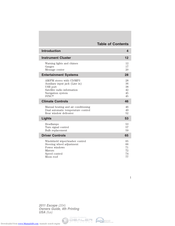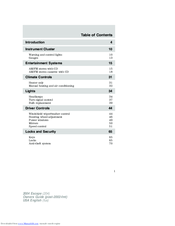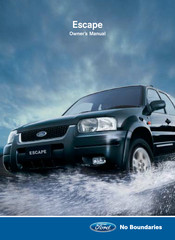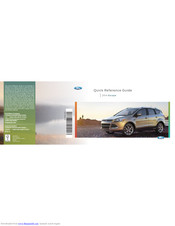- Manuals
- Brands
- Ford Manuals
- Automobile
- ESCAPE
Manuals and User Guides for Ford ESCAPE. We have 13 Ford ESCAPE manuals available for free PDF download: Owner’s Manual, Quick Reference Manual
Ford ESCAPE Owner’s Manual (455 pages)
2015
Brand: Ford
|
Category: Automobile
|
Size: 8.03 MB
Table of Contents
-
Table of Contents
4
-
Introduction
10
-
About this Manual
10
-
Symbols Glossary
10
-
Data Recording
12
-
California Proposition 65
14
-
Perchlorate
14
-
Ford Credit
14
-
Replacement Parts Recommendation
14
-
Special Notices
15
-
Mobile Communications Equipment
16
-
Export Unique Options
16
-
-
Environment
17
-
Protecting the Environment
17
-
-
At a Glance
18
-
Front Exterior Overview
18
-
Vehicle Interior Overview
19
-
Instrument Panel Overview
20
-
Rear Exterior Overview
21
-
-
Child Safety
23
-
General Information
23
-
Installing Child Seats
24
-
Using Lap and Shoulder Belts
25
-
Using Tether Straps
29
-
-
Booster Seats
30
-
Types of Booster Seats
31
-
Child Seat Positioning
32
-
Child Safety Locks
33
-
Left-Hand Side
34
-
Right-Hand Side
34
-
-
-
Safety Belts
35
-
Principle of Operation
35
-
Fastening the Safety Belts
36
-
Using Safety Belts During Pregnancy
36
-
Safety Belt Locking Modes
37
-
Safety Belt Extension Assembly
38
-
-
Safety Belt Height Adjustment
39
-
Safety Belt Warning Lamp and Indicator Chime
39
-
Safety Belt Minder
40
-
Child Restraint and Safety Belt Maintenance
41
-
-
Personal Safety System?
42
-
Personal Safety System
42
-
-
Supplementary Restraints System
43
-
Principle of Operation
43
-
Driver and Passenger Airbags
44
-
Children and Airbags
44
-
Front Passenger Sensing System
45
-
Side Airbags
47
-
Driver Knee Airbag
48
-
Safety Canopy
48
-
Crash Sensors and Airbag Indicator
50
-
Airbag Disposal
51
-
-
Keys and Remote Controls
52
-
Principle of Operation
52
-
General Information on Radio Frequencies
52
-
Remote Control
53
-
Integrated Keyhead Transmitters
53
-
Replacing the Battery
53
-
Car Finder
54
-
Sounding a Panic Alarm
55
-
-
Replacing a Lost Key or Remote Control
56
-
-
Mykey
57
-
Principle of Operation
57
-
Creating a Mykey
57
-
Clearing All Mykeys
58
-
Checking Mykey System Status
59
-
Using Mykey with Remote Start Systems
60
-
Mykey Troubleshooting
60
-
-
Locks
62
-
Locking and Unlocking
62
-
Power Door Locks
62
-
Opening a Rear Door from Inside
63
-
Mechanical Key
63
-
Illuminated Exit
65
-
Battery Saver
65
-
Illuminated Entry
65
-
-
Manual Liftgate
66
-
Opening the Liftgate
66
-
Closing the Liftgate
66
-
-
Power Liftgate
67
-
Opening and Closing the Liftgate
67
-
Stopping the Liftgate Movement
68
-
Setting the Liftgate Open Height
68
-
Obstacle Detection
69
-
-
Keyless Entry
70
-
-
Security
72
-
Passive Anti-Theft System
72
-
Anti-Theft Alarm
73
-
Arming the Alarm
73
-
Disarming the Alarm
73
-
-
-
Steering Wheel
74
-
Adjusting the Steering Wheel
74
-
Audio Control
74
-
Voice Control
75
-
Cruise Control
75
-
Information Display Control
76
-
-
Wipers and Washers
77
-
Windshield Wipers
77
-
Autowipers
77
-
Intermittent Wipe
77
-
Windshield Washers
78
-
Rear Window Wiper and Washers
79
-
Rear Window Washer
79
-
-
Lighting
80
-
Lighting Control
80
-
Autolamps
80
-
Headlamp Flasher
80
-
High Beams
80
-
-
Instrument Lighting Dimmer
81
-
Vehicles with Front Fog Lamps
81
-
Headlamp Exit Delay
82
-
Vehicles Without Front Fog Lamps
82
-
Daytime Running Lamps
82
-
Type 2 — Configurable
82
-
Front Fog Lamps
83
-
Direction Indicators
83
-
Interior Lamps
83
-
Front Interior Lamp
83
-
Ambient Lighting
84
-
-
Windows and Mirrors
85
-
Power Windows
85
-
Window Lock
85
-
Global Opening
86
-
Exterior Mirrors
86
-
Fold-Away Exterior Mirrors
87
-
Heated Exterior Mirrors
87
-
-
Interior Mirror
88
-
Sun Visors
88
-
Moonroof
89
-
Opening and Closing the Sunscreen
89
-
-
Instrument Cluster
90
-
Gauges
90
-
Information Display
90
-
Fuel Gauge
91
-
Engine Coolant Temperature Gauge
91
-
-
Warning Lamps and Indicators
92
-
Anti-Lock Braking System
92
-
Airbag — Front
92
-
Brake System
92
-
Fasten Safety Belt
93
-
High Beam
93
-
Direction Indicator
93
-
Low Fuel Level
93
-
Low Tire Pressure Warning
93
-
-
Audible Warnings and Indicators
94
-
Headlamps on Warning Chime
95
-
Parking Brake on Warning Chime
95
-
-
-
Information Displays
96
-
General Information
96
-
Trip Computer
98
-
Resetting the Trip Computer
98
-
Information Messages
99
-
Park Aid
105
-
Park Brake
105
-
Power Steering
106
-
Starting System
106
-
Transmission and Four-Wheel Drive
106
-
-
-
Climate Control
109
-
Manual Climate Control
109
-
Automatic Climate Control
110
-
Hints on Controlling the Interior Climate
111
-
Temperature Control
111
-
General Hints
111
-
Heating the Interior Quickly
112
-
Recommended Settings for Heating
112
-
Cooling the Interior Quickly
113
-
Recommended Settings for Cooling
113
-
-
Heated Windows and Mirrors
114
-
Cabin Air Filter
115
-
Remote Start
115
-
Automatic Settings
115
-
Last Settings
115
-
Heated and Cooled Devices
115
-
-
-
Seats
116
-
Sitting in the Correct Position
116
-
Head Restraints
116
-
Adjusting the Head Restraint
117
-
Manual Seats
118
-
Power Seats
119
-
Recline Adjustment
119
-
Memory Function
120
-
Rear Seats
121
-
Saving a Preset Position
121
-
Folding the Seatback
121
-
Unfolding the Seatback
121
-
-
Heated Seats
122
-
Rear Seat Armrest
122
-
Advertisement
Ford ESCAPE Owner’s Manual (362 pages)
2012
Brand: Ford
|
Category: Automobile
|
Size: 2.61 MB
Table of Contents
-
Table of Contents
1
-
Introduction
4
-
Breaking-In the Vehicle
5
-
Service Data Recording
7
-
Event Data Recording
7
-
Vehicle Symbol Glossary
10
-
-
Instrument Cluster
12
-
Warning Lights and Chimes
12
-
Check Fuel Cap Fill Inlet Indicator
13
-
Service Engine Soon: Service
13
-
Service Engine Soon Indicator
13
-
Brake System Warning Light
13
-
Anti-Lock Brake System Indicator
14
-
Airbag Readiness Indicator
14
-
Safety Belt Indicator
14
-
Charging System Indicator
14
-
Engine Oil Pressure Indicator
15
-
Advancetrac Indicator
15
-
Advancetrac off Indicator
15
-
Low Tire Pressure Warning Indicator
15
-
Overdrive Cancel and Grade Assist Indicator
16
-
Throttle Control/Powertrain Indicator
16
-
Door Ajar Indicator
16
-
Key-In-Ignition Warning Chime
16
-
-
Gauges
17
-
Speedometer
18
-
Engine Coolant Temperature Gauge
18
-
Fuel Gauge
18
-
Tachometer
19
-
Odometer
19
-
Trip Odometer
19
-
-
Message Center
20
-
Trip A/B
20
-
Miles (Km) to E
20
-
AVG MPG (L/100Km)
21
-
MPG (L/Km)
21
-
Press Reset for English
22
-
Reset for System Check
22
-
Units
22
-
Autolamp
23
-
Autolock/Autounlock
23
-
Rear Park Aid
23
-
Language = English/Spanish/French
23
-
System Warnings
24
-
-
-
Entertainment Systems
28
-
AM/FM Single CD/MP3 Satellite Compatible Sound System
28
-
Audio Systems
28
-
Setting the Clock
28
-
AM/FM Radio
29
-
Cat/Fold(Category/Folder)
30
-
CD/MP3 Player
30
-
RDS Radio
30
-
Satellite Radio
32
-
Sound Adjustments
35
-
Extra Features
36
-
Auxiliary Input Jack (Line In)
37
-
General Audio Information
39
-
Radio Frequencies
39
-
-
USB Port
39
-
CD/CD Player Care
40
-
Radio Reception Factors
40
-
MP3 Track and Folder Structure
41
-
Sample MP3 Structure
42
-
-
Satellite Radio Information
42
-
Satellite Radio Electronic Serial Number (ESN)
43
-
SIRIUS Satellite Radio Service
43
-
-
Navigation System
45
-
Sync
45
-
-
Climate Controls
46
-
Manual Heating and Air Conditioning System
46
-
For Maximum Cooling Performance in MAX A/C Mode
48
-
To Aid in Side Window Defogging/Demisting in Cold Weather
48
-
Dual Automatic Temperature Control
49
-
Automatic Operation
51
-
For Maximum Cooling Performance
51
-
-
Rear Window Defroster
52
-
-
Lights
53
-
Autolamp Control
53
-
Autolamp Delay System
53
-
Headlamp Control
53
-
Flash-To-Pass
54
-
Fog Lamp Control
54
-
High Beams
54
-
Daytime Running Lamps (DRL)
55
-
Panel Dimmer Control
55
-
Aiming the Headlamps
56
-
Vertical Aim Adjustment
56
-
Dome Lamps and Map Lamps
57
-
Interior Lamps
57
-
Turn Signal Control
57
-
Cargo and Dome Lamp
58
-
Map Lamps
58
-
Ambient Lighting
59
-
-
Bulb Replacement
59
-
Lamp Assembly Condensation
59
-
Replacing Headlamp Bulbs
60
-
Using the Right Bulbs
60
-
Replacing Front Parking Lamp/Turn Signal Bulbs
61
-
Replacing High-Mount Brake Lamp Bulbs
62
-
Replacing Tail/Stop/Turn/Backup Lamp Bulbs
62
-
Replacing License Plate Lamp Bulbs
63
-
Replacing Fog Lamp Bulbs
64
-
-
-
Driver Controls
65
-
Multi-Function Lever
65
-
Windshield Wiper Rainlamp Feature
65
-
Windshield Wiper/Washer Controls
65
-
Rear Window Wiper/Washer Controls
66
-
Steering Wheel Adjustment
66
-
Tilt Steering Wheel
66
-
Illuminated Visor Mirror
67
-
Overhead Console
67
-
Slide-On-Rod Feature
67
-
Storage Compartment
67
-
Compass Zone Adjustment
68
-
Electronic Compass
68
-
Center Console
69
-
Compass Calibration Adjustment
69
-
Auxiliary Power Point (12V DC)
70
-
-
Power Windows
71
-
Rear Window Buffeting
71
-
Accessory Delay
72
-
Automatic Dimming Interior Rear View Mirror
72
-
Interior Mirror
72
-
Window Lock
72
-
Exterior Mirrors
73
-
Fold-Away Mirrors
73
-
Power Side View Mirrors
73
-
Heated Outside Mirrors
74
-
-
Speed Control
74
-
Increasing Speed While Using Speed Control
75
-
Reducing Speed While Using Speed Control
75
-
Steering Wheel Controls
76
-
Turning off Speed Control
76
-
Navigation System/Sync Hands-Free Control Features
77
-
SYNC System Hands-Free Control Feature
77
-
Bounce-Back
78
-
Bounce-Back Override
78
-
-
Moon Roof
78
-
Car2U Home Automation System
79
-
To Vent
79
-
Universal Garage Door Opener
79
-
Types of Garage Door Openers (Rolling Code and Fixed Code)
80
-
Rolling Code Programming
81
-
Fixed Code Programming
83
-
Erasing the Car2U Home Automation System Buttons
85
-
Positive Retention Floor Mat
86
-
Liftgate
87
-
Cargo Area Features
88
-
Cargo Management System
88
-
Cargo Shade
88
-
Passenger Side Cargo Compartment
89
-
Roof Rack System
89
-
To Adjust the Cross-Bar (if Equipped) Position
90
-
To Remove the Cross-Bar Assembly from the Roof Rack Side Rails
90
-
To Reinstall the Cross-Bar Assembly to the Roof Rack Side Rails
91
-
-
-
Locks and Security
92
-
Keys
92
-
Mykey Feature
93
-
Mykey Restricted Features
93
-
Create a Mykey
94
-
Programming Mykey Optional Settings
94
-
Clear Mykey
95
-
Check Mykey System Status
95
-
Using Mykey with Remote Start Systems
95
-
Power Door Locks
98
-
Door Key Unlocking/Locking
98
-
Autolock
98
-
Power Door Unlock/Lock Procedure
99
-
Keyless Entry Keypad Procedure
99
-
Autounlock
100
-
Power Door Lock Switch Autounlock Enable/Disable Procedure
100
-
Keyless Entry Keypad Autounlock Enable/Disable Procedure
101
-
Smart Unlocking Feature
101
-
Childproof Door Locks
102
-
Remote Entry System
102
-
Two Step Door Unlocking
103
-
One Step Door Unlocking
103
-
Switching from Two Step to One Step Door Unlocking
104
-
Opening the Liftgate Glass
104
-
Car Finder
104
-
Sounding a Panic Alarm
104
-
Replacing the Battery (Transmitter)
105
-
Replacing Lost Integrated Keyhead Transmitters (Ikts)
105
-
How to Reprogram Your Integrated Keyhead Transmitters (Ikts)
105
-
Securicode Keyless Entry System
106
-
Illuminated Entry
106
-
Illuminated Exit
106
-
Programming Your Own Personal Entry Code
106
-
Erasing Personal Code
107
-
Anti-Scan Feature
107
-
Securilock Passive Anti-Theft System
108
-
Unlocking and Locking the Doors and Liftgate Using Keyless Entry
108
-
Anti-Theft Indicator
109
-
Automatic Arming
109
-
Automatic Disarming
109
-
Replacement of Integrated Keyhead Transmitters (IKT) and Coded Keys
110
-
Programming Spare Keys
110
-
-
Ford ESCAPE Owner’s Manual (430 pages)
Brand: Ford
|
Category: Automobile
|
Size: 5.23 MB
Table of Contents
-
Table of Contents
4
-
Introduction
10
-
About this Manual
10
-
Symbols Glossary
10
-
Data Recording
12
-
California Proposition 65
14
-
Perchlorate
14
-
Ford Credit
14
-
Replacement Parts Recommendation
14
-
Special Notices
15
-
Mobile Communications Equipment
15
-
Export Unique Options
16
-
Child Safety
17
-
General Information
17
-
Child Seat Positioning
18
-
-
Child Safety
19
-
Booster Seats
20
-
Installing Child Seats
22
-
Using Lap and Shoulder Belts
22
-
-
Child Safety Locks
27
-
Safety Belts
29
-
Principle of Operation
29
-
Fastening the Safety Belts
30
-
-
Safety Belts
31
-
Safety Belt Height Adjustment
33
-
Safety Belt Warning Lamp and Indicator Chime
33
-
Safety Belt Minder
34
-
Child Restraint and Safety Belt Maintenance
35
-
-
Personal Safety System?
37
-
Personal Safety System
37
-
-
Supplementary Restraints System
38
-
Principle of Operation
38
-
Driver and Passenger Airbags
39
-
Driver Knee Airbag
40
-
Front Passenger Sensing System
40
-
Escape/Kuga (TM2
40
-
Supplementary Restraints System
41
-
Side Airbags
42
-
Safety Canopy
43
-
Crash Sensors and Airbag Indicator
44
-
Airbag Disposal
45
-
Keys and Remote Controls
46
-
General Information on Radio
46
-
Frequencies
46
-
Remote Control
46
-
-
Keys and Remote Controls
47
-
Replacing the Battery
47
-
Sounding a Panic Alarm
49
-
Replacing a Lost Key or Remote Control
50
-
-
Mykey
51
-
Principle of Operation
51
-
Creating a Mykey
52
-
Clearing All Mykeys
52
-
Checking Mykey System Status
52
-
Using Mykey with Remote Start Systems
53
-
Mykey Troubleshooting
54
-
-
Locks
57
-
Locking and Unlocking
57
-
Power Door Locks
57
-
Remote Control
57
-
Mechanical Key
58
-
Opening a Rear Door from Inside
58
-
-
Manual Liftgate
61
-
Opening the Liftgate
61
-
Closing the Liftgate
61
-
-
Power Liftgate
62
-
Opening and Closing the Liftgate
62
-
-
Keyless Entry
64
-
Setting the Liftgate Open Height
64
-
Obstacle Detection
64
-
-
-
Security
66
-
Passive Anti-Theft System
66
-
Anti-Theft Alarm
67
-
-
Steering Wheel
68
-
Adjusting the Steering Wheel
68
-
Audio Control
68
-
Steering Wheel
69
-
Voice Control
70
-
Cruise Control
70
-
Information Display Control
70
-
Myford Touch® Controls
70
-
Multimedia Controls
71
-
-
-
Wipers and Washers
72
-
Windshield Wipers
72
-
Autowipers
72
-
Intermittent Wipe
72
-
-
Windshield Washers
73
-
Rear Window Wiper and Washers
74
-
-
Lighting
75
-
Lighting Control
75
-
Autolamps
75
-
High Beams
75
-
-
Instrument Lighting Dimmer
76
-
Vehicles with Front Fog Lamps
76
-
Vehicles Without Front Fog Lamps
76
-
-
Headlamp Exit Delay
77
-
Daytime Running Lamps
77
-
Front Fog Lamps
77
-
Direction Indicators
77
-
Interior Lamps
77
-
Front Interior Lamp
78
-
Rear Interior Lamp
78
-
-
Ambient Lighting
79
-
Windows and Mirrors
80
-
Power Windows
80
-
Window Lock
80
-
-
Exterior Mirrors
81
-
Interior Mirror
82
-
Sun Visors
83
-
Moonroof
83
-
-
Windows and Mirrors
84
-
Instrument Cluster
85
-
Gauges
85
-
Fuel Gauge
86
-
Engine Coolant Temperature Gauge
86
-
-
Warning Lamps and Indicators
87
-
Direction Indicator
88
-
Engine Oil
88
-
Fasten Safety Belt
88
-
High Beam
88
-
Low Fuel Level
88
-
Low Tire Pressure Warning
88
-
-
Audible Warnings and Indicators
89
-
-
Instrument Cluster
90
-
Information Displays
91
-
General Information
91
-
Information Displays
92
-
Trip Computer
93
-
Information Messages
94
-
Park Aid
100
-
Park Brake
100
-
-
-
Climate Control
104
-
Manual Climate Control
104
-
Automatic Climate Control
105
-
Climate Control
106
-
Hints on Controlling the Interior Climate
107
-
Heating the Interior Quickly
107
-
-
Heated Windows and Mirrors
110
-
Cabin Air Filter
110
-
Remote Start
110
-
-
Seats
112
-
Sitting in the Correct Position
112
-
Head Restraints
112
-
Adjusting the Head Restraint
113
-
-
Manual Seats
114
-
Power Seats
115
-
Recline Adjustment
115
-
-
Memory Function
116
-
Rear Seats
117
-
Heated Seats
118
-
Rear Seat Armrest
118
-
Advertisement
Ford ESCAPE Owner’s Manual (434 pages)
2013
Brand: Ford
|
Category: Automobile
|
Size: 5.65 MB
Table of Contents
-
Table of Contents
4
-
Introduction
10
-
About this Manual
10
-
Symbols Glossary
10
-
Data Recording
12
-
California Proposition 65
14
-
Perchlorate
14
-
Ford Credit
14
-
Replacement Parts Recommendation
14
-
Special Notices
15
-
Mobile Communications Equipment
15
-
Export Unique Options
16
-
Child Safety
17
-
General Information
17
-
-
Child Safety
18
-
Child Seat Positioning
19
-
Booster Seats
20
-
Types of Booster Seats
21
-
-
Installing Child Seats
22
-
Using Lap and Shoulder Belts
23
-
Using Tether Straps
27
-
-
Child Safety Locks
28
-
-
Safety Belts
29
-
Principle of Operation
29
-
Fastening the Safety Belts
30
-
Safety Belt Height Adjustment
33
-
Safety Belt Warning Lamp and Indicator Chime
33
-
Safety Belt Minder
34
-
Child Restraint and Safety Belt Maintenance
35
-
-
Personal Safety System?
37
-
Personal Safety System
37
-
-
Supplementary Restraints System
38
-
Principle of Operation
38
-
Driver and Passenger Airbags
39
-
Knee Airbag
40
-
Front Passenger Sensing System
40
-
Side Airbags
43
-
Safety Canopy
44
-
Crash Sensors and Airbag Indicator
45
-
Airbag Disposal
46
-
Keys and Remote Controls
47
-
Principle of Operation
47
-
General Information on Radio Frequencies
47
-
Remote Control
48
-
-
Keys and Remote Controls
49
-
Replacing a Lost Key or Remote Control
51
-
-
Mykey
52
-
Principle of Operation
52
-
Creating a Mykey
52
-
Clearing All Mykeys
53
-
Checking Mykey System Status
53
-
Using Mykey with Remote Start Systems
53
-
Mykey Troubleshooting
54
-
-
Locks
57
-
Locking and Unlocking
57
-
Power Door Locks
57
-
Remote Control
57
-
Illuminated Entry
59
-
Illuminated Exit
59
-
-
Manual Liftgate
60
-
Battery Saver
60
-
Opening the Liftgate
60
-
Closing the Liftgate
60
-
-
Power Liftgate
61
-
Opening and Closing the Liftgate
61
-
-
Keyless Entry
63
-
-
Security
65
-
Passive Anti-Theft System
65
-
Programming Spare Integrated Keyhead Transmitter
65
-
Anti-Theft Alarm
66
-
-
Steering Wheel
67
-
Adjusting the Steering Wheel
67
-
Audio Control
67
-
Voice Control
69
-
Cruise Control
69
-
Information Display Control
69
-
-
Wipers and Washers
71
-
Windshield Wipers
71
-
Autowipers
71
-
Windshield Washers
72
-
Rear Window Wiper and Washers
73
-
-
Lighting
74
-
Lighting Control
74
-
Autolamps
74
-
Instrument Lighting Dimmer
75
-
Headlamp Exit Delay
75
-
Daytime Running Lamps
75
-
Front Fog Lamps
76
-
Direction Indicators
76
-
Interior Lamps
76
-
Ambient Lighting
77
-
-
Windows and Mirrors
79
-
Power Windows
79
-
Exterior Mirrors
80
-
Interior Mirror
81
-
Sun Visors
82
-
Moonroof
82
-
Opening and Closing the Sunscreen
82
-
-
Instrument Cluster
84
-
Gauges
84
-
Warning Lamps and Indicators
85
-
-
Instrument Cluster
86
-
Audible Warnings and Indicators
88
-
-
Information Displays
89
-
General Information
89
-
Information Displays
90
-
Trip Computer
91
-
Information Messages
92
-
-
Audio System
102
-
General Information
102
-
Audio Unit — Vehicles With: AM/FM/CD
103
-
Audio Unit — Vehicles With: AM/FM/CD/SYNC
105
-
Audio Unit — Vehicles With: Am/Fm/CD/Sync/Satellite Radio
108
-
Audio Unit — Vehicles With: Premium AM/FM/CD
110
-
Audio Unit — Vehicles With: Sony AM/FM/CD
111
-
Auxiliary Input Jack
115
-
USB Port
115
-
Media Hub
116
-
Satellite Radio
116
-
SIRIUS Satellite Radio Service
117
-
SIRIUS Troubleshooting
117
-
-
-
Climate Control
119
-
Manual Climate Control
119
-
Automatic Climate Control
120
-
Hints on Controlling the Interior Climate
121
-
Heating the Interior Quickly
122
-
-
Climate Control
123
-
Heated Windows and Mirrors
125
-
Cabin Air Filter
125
-
Remote Start
125
-
Ford ESCAPE Owner’s Manual (433 pages)
2013
Brand: Ford
|
Category: Automobile
|
Size: 6.27 MB
Table of Contents
-
Table of Contents
5
-
Introduction
11
-
About this Manual
11
-
Symbols Glossary
11
-
Data Recording
13
-
California Proposition 65
15
-
Perchlorate
15
-
Ford Credit
15
-
Replacement Parts Recommendation
15
-
Special Notices
16
-
Mobile Communications Equipment
16
-
Export Unique Options
17
-
Child Safety
18
-
General Information
18
-
Child Safety
19
-
Child Seat Positioning
20
-
Booster Seats
21
-
Installing Child Seats
23
-
Child Safety Locks
29
-
Safety Belts
30
-
Principle of Operation
30
-
Fastening the Safety Belts
31
-
Safety Belt Height Adjustment
34
-
Safety Belt Warning Lamp and Indicator Chime
34
-
Safety Belt Minder
35
-
Child Restraint and Safety Belt Maintenance
36
-
Personal Safety System
38
-
Supplementary Restraints System
39
-
Principle of Operation
39
-
Driver and Passenger Airbags
40
-
Knee Airbag
41
-
Front Passenger Sensing System
41
-
Escape (TM2
41
-
Side Airbags
44
-
Safety Canopy
45
-
Crash Sensors and Airbag Indicator
46
-
Airbag Disposal
47
-
Keys and Remote Controls
48
-
Principle of Operation
48
-
General Information on Radio Frequencies
48
-
Remote Control
49
-
Replacing a Lost Key or Remote Control
52
-
Mykey
53
-
Principle of Operation
53
-
Creating a Mykey
53
-
Clearing All Mykeys
54
-
Checking Mykey System Status
55
-
Using Mykey with Remote Start Systems
55
-
Mykey Troubleshooting
55
-
Locks
57
-
Locking and Unlocking
57
-
Remote Control
57
-
Manual Liftgate
60
-
Power Liftgate
61
-
Keyless Entry
63
-
Security
65
-
Passive Anti-Theft System
65
-
Programming Spare Integrated Keyhead Transmitter
65
-
Anti-Theft Alarm
66
-
Steering Wheel
67
-
Adjusting the Steering Wheel
67
-
Audio Control
67
-
Voice Control
69
-
Cruise Control
69
-
Information Display Control
69
-
Wipers and Washers
71
-
Windshield Wipers
71
-
Autowipers
71
-
Windshield Washers
72
-
Rear Window Wiper and Washers
73
-
Lighting
74
-
Lighting Control
74
-
Autolamps
74
-
Instrument Lighting Dimmer
75
-
Headlamp Exit Delay
75
-
Daytime Running Lamps
75
-
Front Fog Lamps
76
-
Direction Indicators
76
-
Interior Lamps
76
-
Ambient Lighting
77
-
Windows and Mirrors
79
-
Power Windows
79
-
Exterior Mirrors
80
-
Interior Mirror
81
-
Sun Visors
82
-
Moonroof
82
-
Instrument Cluster
84
-
Gauges
84
-
Warning Lamps and Indicators
85
-
Instrument Cluster
86
-
Audible Warnings and Indicators
88
-
Information Displays
89
-
General Information
89
-
Trip Computer
91
-
Information Messages
92
-
Keyless Vehicle Information Display
95
-
Lighting Display
96
-
Audio System
102
-
General Information
102
-
Audio Unit — Vehicles With: AM/FM/CD
103
-
Audio Unit — Vehicles With: AM/FM/CD/SYNC
105
-
Audio Unit — Vehicles With: Am/Fm/CD/Sync/Satellite Radio
107
-
Audio Unit — Vehicles With: Premium AM/FM/CD
109
Ford ESCAPE Owner’s Manual (368 pages)
Brand: Ford
|
Category: Automobile
|
Size: 2.66 MB
Table of Contents
-
Table of Contents
1
-
Introduction
4
-
Instrument Cluster
12
-
Warning Lights and Chimes
12
-
Service Engine Soon: Service
13
-
Check Fuel Cap
13
-
-
Gauges
17
-
Message Center
20
-
-
Entertainment Systems
28
-
Auxiliary Input Jack (Line In)
36
-
Play Music Player Using Auxiliary Input
37
-
Auxiliary Input Jack
37
-
-
USB Port
38
-
Satellite Radio Information
42
-
Navigation System
45
-
Sync
45
-
-
Climate Controls
46
-
Manual Heating and Air Conditioning
46
-
Dual Automatic Temperature Control
49
-
Rear Window Defroster
52
-
-
Lights
53
-
Headlamps
53
-
Turn Signal Control
57
-
Bulb Replacement
59
-
-
Driver Controls
65
-
Windshield Wiper/Washer Control
65
-
Steering Wheel Adjustment
66
-
Power Windows
71
-
Mirrors
73
-
Speed Control
74
-
Moon Roof
77
-
-
Locks and Security
91
-
Keys
91
-
Locks
97
-
Anti-Theft System
107
-
-
Seating and Safety Restraints
111
-
Seating
111
-
Safety Restraints
123
-
Airbags
137
-
Child Restraints
153
-
-
Tires, Wheels and Loading
171
-
Tire Information
173
-
Tire Inflation
176
-
Tire Pressure Monitoring System (TPMS)
188
-
Vehicle Loading
192
-
Trailer Towing
200
-
Recreational Towing
203
-
-
Driving
205
-
Starting
205
-
Brakes
211
-
Advancetrac
214
-
Transmission Operation
223
-
Reverse Sensing System
227
-
Rear-View Camera System
229
-
Ford ESCAPE Owner’s Manual (296 pages)
Brand: Ford
|
Category: Automobile
|
Size: 2.91 MB
Table of Contents
-
Table of Contents
1
-
Introduction
4
-
Instrument Cluster
12
-
Warning Lights and Chimes
12
-
Gauges
17
-
-
Entertainment Systems
20
-
Auxiliary Input Jack
27
-
Satellite Radio Information
30
-
Navigation System
33
-
-
Climate Controls
34
-
Manual Heating and Air Conditioning
34
-
Dual Automatic Temperature Control
37
-
Rear Window Defroster
40
-
-
Lights
41
-
Headlamps
41
-
Turn Signal Control
45
-
Bulb Replacement
47
-
-
Driver Controls
52
-
Windshield Wiper/Washer Control
52
-
Steering Wheel Adjustment
53
-
Power Windows
56
-
Mirrors
60
-
Speed Control
61
-
Moon Roof
65
-
Message Center
66
-
-
Locks and Security
78
-
Keys
78
-
Locks
80
-
Anti-Theft System
91
-
Programming Spare Keys
93
-
-
Seating and Safety Restraints
95
-
Seating
95
-
Safety Restraints
103
-
Airbags
116
-
Child Restraints
131
-
-
Tires, Wheels and Loading
143
-
Tire Information
146
-
Tire Inflation
148
-
Tire Pressure Monitoring System (TPMS)
161
-
Vehicle Loading
166
-
Trailer Towing
172
-
Recreational Towing
177
-
-
Driving
178
-
Starting
178
-
Brakes
182
-
Traction Control™/Advancetrac
184
-
Transmission Operation
190
-
-
Roadside Emergencies
206
-
Getting Roadside Assistance
206
-
Hazard Flasher Switch
208
-
Fuel Pump Shut-Off Switch
208
-
Fuses and Relays
209
-
Passenger Compartment Fuse Panel
210
-
Power Distribution Box
213
-
-
Changing Tires
216
-
Lug Nut Torque
226
-
Jump Starting
227
-
Wrecker Towing
232
-
Ford ESCAPE Owner’s Manual (296 pages)
Brand: Ford
|
Category: Automobile
|
Size: 3.18 MB
Table of Contents
-
Table of Contents
1
-
Introduction
4
-
Vehicle Symbol Glossary
8
-
-
Instrument Cluster
10
-
Warning and Control Lights
10
-
Gauges
15
-
-
Entertainment Systems
17
-
AM/FM Stereo with In-Dash Six CD
17
-
AM/FM Stereo Cassette with CD
31
-
-
Climate Controls
38
-
Heater Only
38
-
Manual Heating and Air Conditioning
39
-
Rear Window Defroster
40
-
-
Lights
41
-
Headlamps
41
-
Turn Signal Control
46
-
Bulb Replacement
47
-
-
Driver Controls
52
-
Windshield Wiper/Washer Control
52
-
Steering Wheel Adjustment
53
-
Power Windows
55
-
Mirrors
57
-
Speed Control
58
-
Message Center
62
-
-
Locks and Security
75
-
Keys
75
-
Locks
75
-
Anti-Theft System
84
-
-
Seating and Safety Restraints
89
-
Seating
89
-
Safety Restraints
97
-
Airbags
112
-
Child Restraints
127
-
-
Tires, Wheels and Loading
139
-
Tire Information
141
-
Tire Inflation
143
-
Tire Pressure Monitoring System (TPMS)
156
-
Vehicle Loading
162
-
Trailer Towing
169
-
Recreational Towing
174
-
-
Driving
175
-
Starting
175
-
Brakes
178
-
Transmission Operation
182
-
-
Roadside Emergencies
200
-
Getting Roadside Assistance
200
-
Hazard Flasher Switch
201
-
Fuel Pump Shut-Off Switch
202
-
Fuses and Relays
202
-
Changing Tires
209
-
Lug Nut Torque
220
-
Jump Starting
220
-
Wrecker Towing
226
-
Ford ESCAPE Owner’s Manual (240 pages)
2004
Brand: Ford
|
Category: Automobile
|
Size: 2.62 MB
Table of Contents
-
Table of Contents
1
-
Introduction
4
-
Vehicle Symbol Glossary
8
-
-
Instrument Cluster
10
-
Warning and Control Lights
10
-
Gauges
13
-
-
Entertainment Systems
15
-
AM/FM Stereo with CD
15
-
AM/FM Stereo Cassette with CD
18
-
-
Climate Controls
31
-
Heater Only
31
-
Manual Heating and Air Conditioning
32
-
-
Lights
34
-
Headlamps
34
-
Turn Signal Control
37
-
Bulb Replacement
39
-
-
Driver Controls
44
-
Windshield Wiper/Washer Control
44
-
Steering Wheel Adjustment
46
-
Power Windows
49
-
Mirrors
50
-
Speed Control
51
-
-
Locks and Security
65
-
Keys
65
-
Locks
65
-
Anti-Theft System
70
-
-
Seating and Safety Restraints
75
-
Seating
75
-
Safety Restraints
85
-
Air Bags
96
-
Child Restraints
103
-
-
Driving
115
-
Starting
115
-
Brakes
119
-
Transmission Operation
121
-
Trailer Towing
143
-
-
Roadside Emergencies
149
-
Getting Roadside Assistance
149
-
Hazard Flasher Switch
150
-
Fuel Pump Shut-Off Switch
150
-
Fuses and Relays
151
-
Passenger Compartment Fuse Panel
152
-
Changing Tires
158
-
Jump Starting
164
-
Wrecker Towing
169
-
-
Customer Assistance
171
-
Reporting Safety Defects (U.S. Only)
179
-
-
Cleaning
180
-
Maintenance and Specifications
186
-
Engine Compartment
188
-
Engine Oil
190
-
Battery
194
-
Fuel Information
201
-
Air Filter(S)
214
-
Part Numbers
220
-
Refill Capacities
220
-
Lubricant Specifications
223
-
Ford ESCAPE Owner’s Manual (202 pages)
Brand: Ford
|
Category: Automobile
|
Size: 3.21 MB
Table of Contents
-
Table of Contents
2
-
Introduction
4
-
Instrumentation
7
-
Controls and Features
17
-
Audio Systems
23
-
Seating and Safety Restraints
76
-
Starting
103
-
Driving
106
-
Roadside Emergencies
129
-
Maintenance and Care
148
-
Capacities and Specifications
182
-
Index
186
Ford ESCAPE Owner’s Manual (16 pages)
Ford Motor Company 2002 Ford Explorer Sport Trac Owner’s Guide
Brand: Ford
|
Category: Automobile
|
Size: 0.19 MB
Table of Contents
-
Table of Contents
1
-
Introduction
2
-
Notice to 4X2 Utility Vehicle Owners
3
-
Vehicle Characteristics
4
-
Operation on the Road
6
-
Driving Off-Road
9
-
Trailer Towing
12
-
Tires, Replacement Requirements
13
-
Maintenance and Modifications
15
-
Hauling Cargo and Vehicle Handling
16
Ford ESCAPE Quick Reference Manual (10 pages)
2014
Brand: Ford
|
Category: Automobile
|
Size: 2.01 MB
Table of Contents
-
Quick Reference Guide
1
-
Instrument Panel
3
-
Sync with Myford Touch
5
-
Essential Information
7
Ford ESCAPE Quick Reference Manual (10 pages)
2013
Brand: Ford
|
Category: Automobile
|
Size: 2.09 MB
Table of Contents
-
Quick Reference Guide
1
-
Instrument Panel
3
-
Sync with Myford Touch
5
-
Essential Information
7
Advertisement
Related Products
-
Ford ESCAPE 2005
-
Ford Escape Hybrid 2007
-
Ford Escape Hybrid
-
Ford Escape 2013
-
Ford ESCAPE 2017
-
Ford ESCAPE 2014
-
Ford Escape 2019
-
Ford Escape 2022
-
Ford Escort 2001
-
Ford Escort
Ford Categories
Automobile
Automobile Accessories
Engine
Trucks
Portable Generator
More Ford Manuals
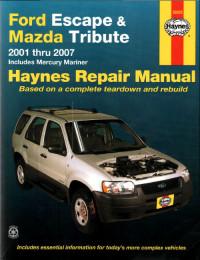
Руководство на английском языке по техническому обслуживанию и ремонту Ford Escape и Mazda Tribute 2001-2007 годов выпуска.
- Автор: —
- Издательство: Haynes Publishing
- Год издания: —
- Страниц: —
- Формат: PDF
- Размер: 89,9 Mb
Руководство на английском языке по техническому обслуживанию и ремонту Ford Escape 2001-2006 годов выпуска.
- Автор: —
- Издательство: Ford Motor Company
- Год издания: —
- Страниц: —
- Формат: PDF
- Размер: 89,4 Mb

Руководство по эксплуатации, техническому обслуживанию и ремонту + каталог расходных запчастей Ford Escape и Ford Maverick 2000-2007 годов выпуска с бензиновыми двигателями.
- Автор: —
- Издательство: Легион-Автодата
- Год издания: —
- Страниц: 582
- Формат: —
- Размер: —

Руководство по эксплуатации и ремонту Ford Escape, Ford Maverick и Mazda Tribute с 2000 года выпуска с бензиновыми двигателями.
- Автор: —
- Издательство: Монолит
- Год издания: —
- Страниц: 358
- Формат: —
- Размер: —
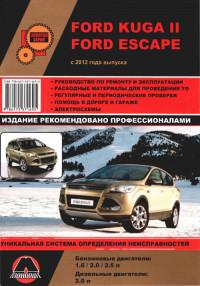
Руководство по эксплуатации и ремонту Ford Escape и Ford Kuga II с 2012 года выпуска с бензиновыми и дизельными двигателями.
- Автор: —
- Издательство: Монолит
- Год издания: 2014
- Страниц: 521
- Формат: —
- Размер: —

Руководство по эксплуатации и ремонту автомобилей Ford Escape и Ford Kuga II с 2012 года выпуска с бензиновыми и дизельными двигателями.
- Автор: —
- Издательство: Монолит
- Год издания: —
- Страниц: 526
- Формат: —
- Размер: —
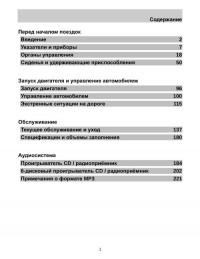
Руководство по эксплуатации Ford Escape 2008 года выпуска.
- Автор: —
- Издательство: Ford Motor Company
- Год издания: —
- Страниц: 223
- Формат: PDF
- Размер: 2,6 Mb

Руководство по эксплуатации, техническому обслуживанию и ремонту Ford Escape, Ford Maverick и Mazda Tribute с 2000 года выпуска с бензиновыми двигателями.
- Автор: —
- Издательство: Арго-Авто
- Год издания: —
- Страниц: 528
- Формат: —
- Размер: —

Сборник руководств на русском и английском языках по эксплуатации, техническому обслуживанию и ремонту Ford Escape с 2008 года выпуска.
- Автор: —
- Издательство: —
- Год издания: —
- Страниц: —
- Формат: multimedia
- Размер: 264,2 Mb
Ford Escape Automobile PDF User Guides and Manuals for Free Download: Found (13) Manuals for Ford Escape Device Model (Owner’s Manual, Quick Reference Manual)
More Automobile Device Models:
-
Roadtrek
SS Agile 2016
Owner’s Manual 2016 SS Agile Erwin Hymer Group North America, Inc. PLEASE NOTE: Through our efforts to improve our manuals and other instructional documents, we at Erwin Hymer Group NA are in the process of renewing the way in which we share information with you, our owners. We are aware of the blank …
SS Agile 2016 Automobile, 134
-
GMC
Hummer H2 2004
2004 RESTRAINTSSeat Belts — Hummer H2 SPECIFICATIONS FASTENER TIGHTENING SPECIFICATIONS Fastener Tightening Specifications SCHEMATIC AND ROUTING DIAGRAMS SEAT BELT SCHEMATIC ICONS Seat Belt Schematic Icons ApplicationSpecificationMetric EnglishFront Seat Belt Buckle Nut 53 N.m 39 lb ftFront Seat Retractor Bolt 53 N.m 3 …
Hummer H2 2004 Automobile, 53
-
Mercedes-Benz
E-Class Sedan
Digital–inthe vehicleVehicle document walletDigital –onthe InternetDigital –asanAppFamiliarize yourself withthe con‐tents of theOperator’s Manualdirectly via thevehicle’s multi‐media system (menu item «Vehi‐cle»). Startwiththe quickguide,discoveryour vehicle’s highlightsor broaden y …
E-Class Sedan Cars, 482
-
Mitsubishi
Pajero Sport 1996
334445464748494:545558595:6465666768696:75848587883343<33483<*HQHUDO 111111111111111111111111(QJLQH 1111111111111111111111111(QJLQH /XEULFDWLRQ 1111111111111)XHO 111111111111111111111111111(QJLQH &RROLQJ 11111111111111111,QWDNH DQG ([KDXVW 111111111111(QJLQH (OHFWULFDO 111111111111111(QJLQH DQG (PLVVLRQ & …
Pajero Sport 1996 Automobile, 923
Recommended Documentation:
Посмотреть инструкция для Ford Escape (2020) бесплатно. Руководство относится к категории автомобили, 2 человек(а) дали ему среднюю оценку 9.4. Руководство доступно на следующих языках: английский. У вас есть вопрос о Ford Escape (2020) или вам нужна помощь? Задайте свой вопрос здесь
Форд Эскейп (2020) — это среднеразмерный кроссовер, который предлагает комфортабельную и практичную поездку. Этот автомобиль доступен во многих комплектациях и оснащен различными двигателями, в том числе экономным гибридным вариантом. Автомобиль оснащен такими функциями, как автоматический тормоз в экстренных ситуациях, система предупреждения о пересечении разметки и мониторинг слепых зон, что повышает безопасность водителя и пассажиров.
Кабина Форд Эскейп (2020) предлагает щедрое пространство для пассажиров и багажа, а также разнообразные технологические возможности, включая 4G LTE Wi-Fi и Apple CarPlay и Android Auto совместимость. У автомобиля хорошее соотношение мощности и экономии топлива, особенно при использовании гибридной версии, что делает его хорошим выбором для повседневных поездок.
Форд Эскейп (2020) также имеет привлекательный дизайн, сочетающий в себе острые линии и скругления, а также узнаваемую решетку радиатора Форда. Внешний вид автомобиля зависит от выбранной комплектации, но в целом он имеет современный и спортивный вид.
Как и любой автомобиль, Форд Эскейп (2020) имеет свои недостатки, но в целом это хороший выбор для тех, кто ищет комфортный и надежный автомобиль среднего размера.
Главная
| Ford | |
| Escape (2020) | |
| автомобиль | |
| английский | |
| Руководство пользователя (PDF), Сведения о гарантии (PDF) |
Не можете найти ответ на свой вопрос в руководстве? Вы можете найти ответ на свой вопрос ниже, в разделе часто задаваемых вопросов о Ford Escape (2020).
Как перевести мили в километры?
1 миля равна 1,609344 километрам, а 1 километр — 0,62137119 милям.
Где я могу узнать идентификационный номер транспортного средства Ford?
Место размещения идентификационного номера транспортного средства зависит от марки и типа транспортного средства. Номер может быть выбит на раме транспортного средства или указан на номерном знаке. Чтобы узнать место расположения идентификационного номера транспортного средства лучше всего ознакомиться с руководством по эксплуатации Ford Escape (2020).
Что такое идентификационный номер транспортного средства (VIN)?
Идентификационный номер транспортного средства — уникальный для каждого транспортного средства идентификационный номер. Аббревиатура VIN расшифровывается как «Vehicle Identification Number» (Идентификационный номер транспортного средства).
Когда транспортному средству Ford требуется техническое обслуживание?
Регулярное техническое обслуживание необходимо всем транспортным средствам. С информацией о том, как часто необходимо проходить техническое обслуживание и чему именно стоит уделять особое внимание можно ознакомиться в инструкции по техническому обслуживанию. Как правило, транспортное средство требует технического обслуживания каждые 2 года или 30 000 километров пробега.
Когда следует заменять тормозную жидкость на Ford?
Тормозную жидкость рекомендуется менять каждые два года.
В чем разница между топливом E10 и E5?
В топливе E10 содержится до десяти процентов этанола, в то время как в E5 содержится менее пяти процентов. Соответственно, топливо E10 менее вредит окружающей среде.
Одна или несколько дверей не открываются изнутри. Что мне делать?
Скорее всего, замок оснащен защитой от детей и поэтому не может быть открыт изнутри. Процедура открытия замка с защитой от детей зависит от марки и типа замка.
Автомобильный радиоприемник не включается, что делать?
Если автомобильный радиоприемник не включен, на него не будет подаваться питание. Убедитесь, что красный провод подключен к контактному источнику питания, а желтый провод — к источнику питания постоянной мощности.
Инструкция Ford Escape (2020) доступно в русский?
К сожалению, у нас нет руководства для Ford Escape (2020), доступного в русский. Это руководство доступно в английский.
Не нашли свой вопрос? Задайте свой вопрос здесь

March 2019
Second Printing
Litho in U.S.A.
2019 ESCAPE Owner’s Manual
Manual Owner’s ESCAPE 2019
KJ5J 19A321 AB

The information contained in this publication was correct at the time of going to print. In the interest of continuous development, we reserve the right to change specifications, design or equipment at any time without notice or obligation. No part of this publication may be reproduced, transmitted, stored in a retrieval system or translated into any language in any form by any means without our written permission. Errors and omissions excepted.
© Ford Motor Company 2019
All rights reserved.
Part Number: 201807 20190305154727
California Proposition 65


Wash your hands after handling.


Table of Contents
|
Introduction |
|
|
About This Manual …………………………………… |
7 |
|
Symbols Glossary …………………………………….. |
7 |
|
Data Recording …………………………………………. |
9 |
|
Perchlorate ………………………………………………. |
13 |
|
Ford Credit ……………………………………………….. |
13 |
|
Replacement Parts Recommendation |
|
|
………………………………………………………………… |
14 |
|
Special Notices ……………………………………….. |
14 |
|
Mobile Communications Equipment |
|
|
…………………………………………………………………. |
15 |
|
Export Unique Options ………………………….. |
16 |
|
Environment |
|
|
Protecting the Environment ………………….. |
17 |
|
At a Glance |
|
|
Instrument Panel ……………………………………. |
18 |
|
Child Safety |
|
|
General Information ………………………………. |
20 |
|
Installing Child Restraints …………………….. |
22 |
|
Booster Seats ………………………………………….. |
27 |
|
Child Restraint Positioning …………………… |
29 |
|
Child Safety Locks …………………………………… |
31 |
|
Seatbelts |
|
|
Principle of Operation ……………………………. |
33 |
|
Fastening the Seatbelts ……………………….. |
34 |
|
Seatbelt Height Adjustment ………………… |
36 |
|
Seatbelt Warning Lamp and Indicator |
|
|
Chime ……………………………………………………. |
37 |
|
Seatbelt Reminder …………………………………. |
37 |
|
Child Restraint and Seatbelt |
|
|
Maintenance ……………………………………….. |
39 |
|
Seatbelt Extension ………………………………… |
39 |
|
Personal Safety System™ |
|
|
Personal Safety System™ …………………… |
40 |
|
Supplementary Restraints |
|
|
System |
|
|
Principle of Operation ……………………………. |
41 |
|
Driver and Passenger Airbags ………………. |
42 |
|
Front Passenger Sensing System ……….. |
43 |
|
Side Airbags ……………………………………………. |
45 |
|
Driver Knee Airbag ………………………………….. |
47 |
|
Safety Canopy™ …………………………………….. |
47 |
|
Crash Sensors and Airbag Indicator …… |
48 |
|
Airbag Disposal ……………………………………… |
49 |
|
Keys and Remote Controls |
|
|
General Information on Radio |
|
|
Frequencies ………………………………………… |
50 |
|
Remote Control ……………………………………… |
50 |
|
Replacing a Lost Key or Remote Control |
|
|
……………………………………………………………….. |
54 |
|
MyKey™ |
|
|
Principle of Operation …………………………… |
55 |
|
Creating a MyKey …………………………………… |
56 |
|
Clearing All MyKeys ……………………………….. |
57 |
|
Checking MyKey System Status ………….. |
57 |
|
Using MyKey With Remote Start |
|
|
Systems ……………………………………………….. |
58 |
|
MyKey – Troubleshooting …………………….. |
58 |
|
Doors and Locks |
|
|
Locking and Unlocking …………………………. |
60 |
|
Keyless Entry …………………………………………… |
63 |
|
Liftgate |
|
|
Manual Liftgate ……………………………………… |
66 |
|
Power Liftgate ………………………………………… |
67 |
|
Security |
|
|
Passive Anti-Theft System …………………… |
70 |
|
Anti-Theft Alarm ……………………………………. |
70 |
1
Escape (TM2) Canada/United States of America, enUSA, Edition date: 201807, Second-Printing

Table of Contents
|
Steering Wheel |
|
|
Adjusting the Steering Wheel ………………. |
72 |
|
Audio Control ………………………………………….. |
72 |
|
Voice Control …………………………………………… |
73 |
|
Cruise Control …………………………………………. |
73 |
|
Information Display Control …………………. |
74 |
|
Heated Steering Wheel …………………………. |
74 |
|
Wipers and Washers |
|
|
Windshield Wipers …………………………………. |
75 |
|
Autowipers ………………………………………………. |
75 |
|
Windshield Washers ……………………………… |
76 |
|
Rear Window Wiper and Washers ……….. |
77 |
|
Lighting |
|
|
General Information ………………………………. |
78 |
|
Lighting Control ……………………………………… |
78 |
|
Autolamps ………………………………………………. |
79 |
|
Instrument Lighting Dimmer ………………… |
79 |
|
Headlamp Exit Delay ……………………………. |
80 |
|
Daytime Running Lamps ……………………… |
80 |
|
Automatic High Beam Control ……………. |
80 |
|
Front Fog Lamps …………………………………….. |
81 |
|
Cornering Lamps ……………………………………. |
82 |
|
Direction Indicators ……………………………….. |
83 |
|
Interior Lamps ………………………………………… |
83 |
|
Ambient Lighting ……………………………………. |
83 |
|
Information Displays |
|
|
General Information ………………………………. |
95 |
|
Trip Computer ………………………………………… |
98 |
|
Information Messages ………………………….. |
98 |
|
Climate Control |
|
|
Manual Climate Control ………………………. |
110 |
|
Automatic Climate Control …………………… |
111 |
|
Hints on Controlling the Interior Climate |
|
|
……………………………………………………………….. |
113 |
|
Heated Windshield ……………………………….. |
116 |
|
Heated Rear Window ……………………………. |
116 |
|
Heated Exterior Mirrors …………………………. |
116 |
|
Cabin Air Filter ……………………………………….. |
116 |
|
Remote Start ………………………………………….. |
116 |
|
Seats |
|
|
Sitting in the Correct Position ……………… |
118 |
|
Head Restraints …………………………………….. |
118 |
|
Manual Seats ………………………………………… |
120 |
|
Power Seats ……………………………………………. |
121 |
|
Memory Function ………………………………….. |
122 |
|
Rear Seats ……………………………………………… |
124 |
|
Heated Seats …………………………………………. |
124 |
|
Garage Door Opener |
|
|
Universal Garage Door Opener ………….. |
126 |
|
Windows and Mirrors |
Auxiliary Power Points |
|||
|
Power Windows …………………………………….. |
85 |
Auxiliary Power Points ………………………….. |
131 |
|
|
Exterior Mirrors ……………………………………….. |
86 |
Storage Compartments |
||
|
Interior Mirror ………………………………………….. |
88 |
133 |
||
|
Sun Visors |
88 |
Center Console ……………………………………… |
||
|
Overhead Console |
133 |
|||
|
Moonroof |
88 |
|||
|
Rear Seat Armrest |
133 |
|||
|
Instrument Cluster |
||||
|
Starting and Stopping the |
||||
|
Gauges …………………………………………………….. |
90 |
|||
|
Warning Lamps and Indicators |
91 |
Engine |
||
|
General Information |
134 |
|||
|
Audible Warnings and Indicators |
94 |
|||
|
2 |
Escape (TM2) Canada/United States of America, enUSA, Edition date: 201807, Second-Printing

Table of Contents
|
Ignition Switch ………………………………………. |
134 |
Stability Control |
||
|
Keyless Starting ……………………………………. |
134 |
Principle of Operation …………………………. |
168 |
|
|
Starting a Gasoline Engine ………………….. |
135 |
Using Stability Control ………………………… |
169 |
|
|
Engine Block Heater ……………………………… |
137 |
Parking Aids |
||
|
UniqueDrivingCharacteristics |
||||
|
Principle of Operation ………………………….. |
170 |
|||
|
Auto-Start-Stop |
139 |
Rear Parking Aid ……………………………………. |
170 |
|
|
Front Parking Aid |
171 |
|||
|
Fuel and Refueling |
Side Sensing System ……………………………. |
172 |
||
|
141 |
Active Park Assist …………………………………. |
174 |
||
|
Safety Precautions ………………………………… |
Rear View Camera |
180 |
||
|
Fuel Quality — E85 |
141 |
|||
|
Cruise Control |
||||
|
Fuel Quality — Gasoline ………………………… |
143 |
|||
|
Fuel Filler Funnel Location ………………….. |
143 |
Principle of Operation |
184 |
|
|
Running Out of Fuel |
143 |
|||
|
Using Cruise Control |
184 |
|||
|
Refueling |
145 |
|||
|
Using Adaptive Cruise Control |
185 |
|||
|
Fuel Consumption |
148 |
|||
|
Driving Aids |
||||
|
Engine Emission Control |
||||
|
150 |
Driver Alert ……………………………………………… |
191 |
||
|
Emission Law ………………………………………… |
Lane Keeping System |
192 |
||
|
Catalytic Converter |
151 |
|||
|
Blind Spot Information System |
197 |
|||
|
Transmission |
Cross Traffic Alert …………………………………. |
198 |
||
|
154 |
Steering ………………………………………………….. |
201 |
||
|
Automatic Transmission ……………………… |
Collision Warning System |
201 |
||
|
Four-Wheel Drive |
|
|
Principle of Operation ………………………….. |
158 |
|
Using Four-Wheel Drive ………………………. |
158 |
|
Brakes |
|
|
General Information …………………………….. |
163 |
|
Hints on Driving With Anti-Lock Brakes |
|
|
………………………………………………………………. |
163 |
|
Electric Parking Brake ………………………….. |
164 |
|
Hill Start Assist ……………………………………… |
165 |
|
Traction Control |
|
|
Principle of Operation ………………………….. |
167 |
|
Using Traction Control …………………………. |
167 |
3
|
Load Carrying |
|
|
Rear Under Floor Storage …………………… |
204 |
|
Luggage Covers ……………………………………. |
204 |
|
Roof Racks and Load Carriers …………… |
205 |
|
Load Limit …………………………………………….. |
206 |
|
Towing |
|
|
Towing a Trailer ………………………………………. |
211 |
|
Trailer Sway Control ……………………………… |
212 |
|
Recommended Towing Weights ………… |
212 |
|
Essential Towing Checks …………………….. |
214 |
|
Towing the Vehicle on Four Wheels …… |
216 |
Escape (TM2) Canada/United States of America, enUSA, Edition date: 201807, Second-Printing

Table of Contents
|
Driving Hints |
|
|
Breaking-In …………………………………………….. |
218 |
|
Economical Driving ………………………………. |
218 |
|
Driving Through Water …………………………. |
219 |
|
Floor Mats ………………………………………………. |
219 |
|
Roadside Emergencies |
|
|
Roadside Assistance ……………………………. |
221 |
|
Hazard Flashers ……………………………………. |
222 |
|
Fuel Shutoff ………………………………………….. |
222 |
|
Jump Starting the Vehicle …………………… |
223 |
|
Post-Crash Alert System ……………………. |
224 |
|
Transporting the Vehicle …………………….. |
225 |
|
Customer Assistance |
|
|
Getting the Services You Need ………….. |
226 |
|
In California (U.S. Only) ………………………. |
227 |
|
The Better Business Bureau (BBB) Auto |
|
|
Line Program (U.S. Only) ………………… |
228 |
|
Utilizing the Mediation/Arbitration |
|
|
Program (Canada Only) …………………. |
229 |
|
Getting Assistance Outside the U.S. and |
|
|
Canada ………………………………………………. |
229 |
|
Ordering Additional Owner’s Literature |
|
|
………………………………………………………………. |
231 |
|
Reporting Safety Defects (U.S. Only) |
|
|
………………………………………………………………. |
231 |
|
Reporting Safety Defects (Canada Only) |
|
|
………………………………………………………………. |
231 |
|
Fuses |
|
|
Fuse Specification Chart …………………….. |
233 |
|
Changing a Fuse …………………………………… |
242 |
|
Maintenance |
|
|
General Information ……………………………. |
244 |
|
Opening and Closing the Hood …………. |
244 |
|
Under Hood Overview — 1.5L EcoBoost™ |
|
|
……………………………………………………………… |
246 |
|
Under Hood Overview — 2.0L EcoBoost™ |
|
|
……………………………………………………………… |
247 |
4
|
Under Hood Overview — 2.5L ……………… |
248 |
|
Engine Oil Dipstick — 1.5L EcoBoost™ |
|
|
……………………………………………………………… |
249 |
|
Engine Oil Dipstick — 2.0L EcoBoost™/ |
|
|
2.5L …………………………………………………….. |
249 |
|
Engine Oil Check ………………………………….. |
249 |
|
Oil Change Indicator Reset ………………… |
250 |
|
Engine Coolant Check ………………………….. |
251 |
|
Automatic Transmission Fluid Check |
|
|
……………………………………………………………… |
255 |
|
Brake Fluid Check ………………………………… |
255 |
|
Power Steering Fluid Check ……………….. |
256 |
|
Washer Fluid Check …………………………….. |
256 |
|
Fuel Filter ………………………………………………. |
256 |
|
Changing the 12V Battery …………………… |
256 |
|
Checking the Wiper Blades ……………….. |
258 |
|
Changing the Wiper Blades ……………….. |
259 |
|
Adjusting the Headlamps ………………….. |
259 |
|
Changing a Bulb ……………………………………. |
261 |
|
Changing the Engine Air Filter …………… |
265 |
|
Vehicle Care |
|
|
General Information ……………………………. |
267 |
|
Cleaning Products ……………………………….. |
267 |
|
Cleaning the Exterior …………………………… |
267 |
|
Waxing …………………………………………………… |
269 |
|
Cleaning the Engine ……………………………. |
269 |
|
Cleaning the Windows and Wiper Blades |
|
|
……………………………………………………………… |
269 |
|
Cleaning the Interior ……………………………. |
270 |
|
Cleaning the Instrument Panel and |
|
|
Instrument Cluster Lens …………………. |
270 |
|
Cleaning Leather Seats ………………………… |
271 |
|
Repairing Minor Paint Damage ………….. |
272 |
|
Cleaning the Wheels ……………………………. |
272 |
|
Vehicle Storage …………………………………….. |
272 |
|
Body Styling Kits ………………………………….. |
274 |
|
Wheels and Tires |
|
|
General Information …………………………….. |
275 |
Escape (TM2) Canada/United States of America, enUSA, Edition date: 201807, Second-Printing

Table of Contents
|
Tire Care …………………………………………………. |
277 |
|
Using Summer Tires ……………………………. |
290 |
|
Using Winter Tires ……………………………….. |
290 |
|
Using Snow Chains ………………………………. |
291 |
|
Tire Pressure Monitoring System ……….. |
291 |
|
Changing a Road Wheel …………………….. |
295 |
|
Technical Specifications ……………………. |
300 |
|
CapacitiesandSpecifications |
|
|
Engine Specifications — 1.5L EcoBoost™ |
|
|
………………………………………………………………. |
301 |
|
Engine Specifications — 2.0L EcoBoost™ |
|
|
………………………………………………………………. |
301 |
|
Engine Specifications — 2.5L ………………. |
302 |
|
Motorcraft Parts — 1.5L EcoBoost™ …… |
303 |
|
Motorcraft Parts — 2.0L EcoBoost™ ….304 |
|
|
Motorcraft Parts — 2.5L ……………………….. |
305 |
|
Vehicle Identification Number ………….. |
306 |
|
Vehicle Certification Label …………………. |
307 |
|
Transmission Code Designation ……….. |
307 |
|
Capacities and Specifications — 1.5L |
|
|
EcoBoost™ ………………………………………. |
308 |
|
Capacities and Specifications — 2.0L |
|
|
EcoBoost™ ………………………………………… |
312 |
|
Capacities and Specifications — 2.5L |
|
|
………………………………………………………………. |
317 |
|
Bulb Specification Chart ……………………… |
321 |
|
Audio System |
|
|
General Information …………………………….. |
322 |
|
Audio Unit — Vehicles With: SYNC ……… |
322 |
|
Audio Unit — Vehicles With: SYNC 3 …… |
324 |
|
Audio Unit — Vehicles With: Sony Audio |
|
|
System ……………………………………………….. |
325 |
|
Digital Radio …………………………………………. |
326 |
|
Satellite Radio ……………………………………… |
329 |
|
USB Port ………………………………………………… |
332 |
|
Media Hub …………………………………………….. |
332 |
|
SYNC™ |
|
|
General Information ……………………………. |
333 |
|
Using Voice Recognition …………………….. |
335 |
|
Using SYNC™ With Your Phone ……….. |
337 |
|
SYNC™ Applications and Services …… |
349 |
|
Using SYNC™ With Your Media Player |
|
|
……………………………………………………………… |
354 |
|
SYNC™ Troubleshooting …………………… |
363 |
|
SYNC™ 3 |
|
|
General Information ……………………………… |
371 |
|
Home Screen ……………………………………….. |
383 |
|
Using Voice Recognition …………………….. |
384 |
|
Entertainment ………………………………………. |
391 |
|
Phone …………………………………………………….. |
401 |
|
Navigation ……………………………………………. |
406 |
|
Apps ……………………………………………………….. |
414 |
|
Settings …………………………………………………… |
417 |
|
SYNC™ 3 Troubleshooting ……………….. |
430 |
|
Accessories |
|
|
Accessories …………………………………………… |
444 |
|
Ford Protect |
|
|
Ford Protect …………………………………………. |
446 |
|
Scheduled Maintenance |
|
|
General Maintenance Information …… |
448 |
|
Normal Scheduled Maintenance ………. |
451 |
|
Special Operating Conditions Scheduled |
|
|
Maintenance …………………………………….. |
453 |
|
Scheduled Maintenance Record ………. |
455 |
|
Appendices |
|
|
Electromagnetic Compatibility ………… |
466 |
|
End User License Agreement ……………. |
468 |
|
Declaration of Conformity …………………. |
494 |
5
Escape (TM2) Canada/United States of America, enUSA, Edition date: 201807, Second-Printing

6
Escape (TM2) Canada/United States of America, enUSA, Edition date: 201807, Second-Printing

Introduction
ABOUT THIS MANUAL
Thank you for choosing Ford. We recommend that you take some time to get to know your vehicle by reading this manual. The more that you know about your vehicle, the greater the safety and pleasure you will get from driving it.

Note: This manual describes product features and options available throughout the range of available models, sometimes even before they are generally available. It may describe options not fitted to the vehicle you have purchased.
Note: Some of the illustrations in this manual may show features as used in different models, so may appear different to you on your vehicle.
Note: Always use and operate your vehicle in line with all applicable laws and regulations.
Note: Pass on this manual when selling your vehicle. It is an integral part of your vehicle.
This manual may qualify the location of a component as left-hand side or right-hand side. The side is determined when facing forward in the seat.
7
E154903
A Right-hand side.
BLeft-hand side.
SYMBOLS GLOSSARY
These are some of the symbols you may see on your vehicle.
Air conditioning system
Air conditioning system lubricant type
Anti-lock braking system
Avoid smoking, flames or sparks
Battery
Battery acid
Brake fluid — non petroleum based
Brake system
Escape (TM2) Canada/United States of America, enUSA, Edition date: 201807, Second-Printing
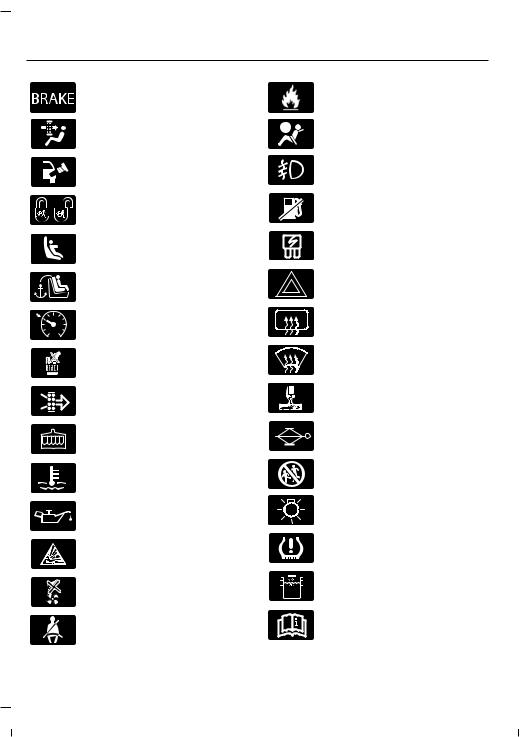
Introduction
Brake system
Cabin air filter
Check fuel cap
Child safety door lock or unlock
Child seat lower anchor
Child seat tether anchor
Cruise control
E71340
Do not open when hot
Engine air filter
Engine coolant
Engine coolant temperature
Engine oil
Explosive gas
Fan warning
Fasten seatbelt
8
Flammable
Front airbag
Front fog lamps
Fuel pump reset
Fuse compartment
Hazard flashers
Heated rear window
Windshield defrosting system
Interior luggage compartment release
Jack
Keep out of reach of children
Lighting control
Low tire pressure warning
Maintain correct fluid level
Note operating instructions
Escape (TM2) Canada/United States of America, enUSA, Edition date: 201807, Second-Printing
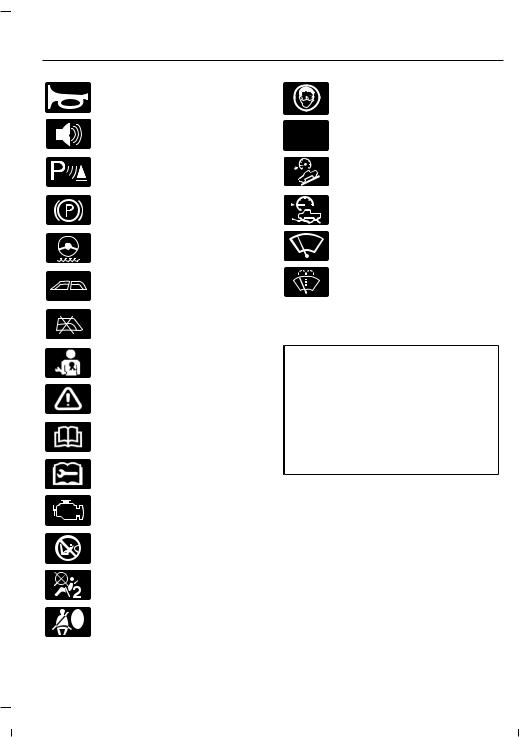
Introduction
Horn control
Panic alarm
Parking aid
E139213
Parking brake
Power steering fluid
Power windows front/rear
Power window lockout
Requires registered technician
Safety alert
See Owner’s Manual
See Service Manual
Service engine soon
Passenger airbag activated
Passenger airbag deactivated
Side airbag
Shield the eyes

Hill descent control
Trail control
Windshield wiping system
Windshield wash and wipe
DATA RECORDING

We respect your privacy and are committed to protecting it. The information contained in this publication was correct at the time of going to print but as technology rapidly changes, we recommend that you visit the regional Ford website for the latest information.
9
Escape (TM2) Canada/United States of America, enUSA, Edition date: 201807, Second-Printing

Introduction
Your vehicle has electronic control units that have data recording functionality and the ability to permanently or temporarily store data. This data could include information on the condition and status of your vehicle, vehicle maintenance requirements, events and malfunctions. The types of data that can be recorded are described in this section. Some of the data recorded is stored in event logs or error logs.
Note: Error logs are reset following a service or repair.
Note: We may provide information in response to requests from law enforcement, other government authorities and third parties acting with lawful authority or through a legal process. Such information could be used by them in legal proceedings.
Data recorded includes, for example:
•Operating states of system components, for example fuel level, tire pressure and battery charge level.
•Vehicle and component status, for example wheel speed, deceleration, lateral acceleration and seatbelt status.
•Events or errors in essential systems, for example headlamps and brakes.
•System responses to driving situations, for example airbag deployment and stability control.
•Environmental conditions, for example temperature.
Some of this data, when used in combination with other information, for example an accident report, damage to a vehicle or eyewitness statements, could be associated with a specific person.
10
Service Data
Service data recorders in your vehicle are capable of collecting and storing diagnostic information about your vehicle. This potentially includes information about the performance or status of various systems and modules in the vehicle, such as engine, throttle, steering or brake systems. In order to properly diagnose and service your vehicle, Ford Motor Company (Ford of Canada in Canada), and service and repair facilities may access or share among them vehicle diagnostic information received through a direct connection to your vehicle when diagnosing or servicing your vehicle. Additionally, Ford Motor Company (Ford of Canada, in Canada) may, where permitted by law, use vehicle diagnostic information for vehicle improvement or with other information we may have about you, (for example, your contact information), to offer you products or services that may interest you. Data may be provided to our service providers such as part suppliers that may help diagnose malfunctions, and who are similarly obligated to protect data. We retain this data only as long as necessary to perform these functions or to comply with law. We may provide information where required in response to official requests to law enforcement or other government authorities or third parties acting with lawful authority or court order, and such information may be used in legal proceedings. For U.S. only (if equipped), if you choose to use connected apps and services, you consent that certain diagnostic information may also be accessed electronically by Ford Motor Company and Ford authorized service facilities, and that the diagnostic information may be used to provide services to you, personalizing your experience, troubleshoot, and to improve products and services and offer you
Escape (TM2) Canada/United States of America, enUSA, Edition date: 201807, Second-Printing

Introduction
products and services that may interest you, where permitted by law. For Canada only, for more information, please review the Ford of Canada privacy policy at www.ford.ca, including our U.S. data storage and use of service providers in other jurisdictions who may be subject to legal requirements in Canada, the United States and other countries applicable to them, for example, lawful requirements to disclose personal information to governmental authorities in those countries.
Event Data
This vehicle is equipped with an event data recorder. The main purpose of an event data recorder is to record, in certain crash or near crash-like situations, such as an airbag deployment or hitting a road obstacle; this data will assist in understanding how a vehicle’s systems performed. The event data recorder is designed to record data related to vehicle dynamics and safety systems for a short period of time, typically 30 seconds or less.
The event data recorder in this vehicle is designed to record such data as:
•How various systems in your vehicle were operating;
•Whether or not the driver and passenger seatbelts were buckled/fastened;
•How far (if at all) the driver was depressing the accelerator and/or the brake pedal; and
•How fast the vehicle was traveling; and
•Where the driver was positioning the steering wheel.
This data can help provide a better understanding of the circumstances in which crashes and injuries occur.
11
Note: Event data recorder data is recorded by your vehicle only if a non-trivial crash situation occurs; no data is recorded by the event data recorder under normal driving conditions and no personal data or information (e.g., name, gender, age, and crash location) is recorded. However, parties, such as law enforcement, could combine the event data recorder data with the type of personally identifying data routinely acquired during a crash investigation.
To read data recorded by an event data recorder, special equipment is required, and access to the vehicle or the event data recorder is needed. In addition to the vehicle manufacturer, other parties, such as law enforcement, that have such special equipment, can read the information if they have access to the vehicle or the event data recorder.
Comfort, Convenience and
Entertainment Data
Your vehicle has electronic control units that have the ability to store data based on your personalized settings. The data is stored locally in the vehicle or on devices that you connect to it, for example, a USB drive or digital music player. You can delete some of this data and also choose whether to share it through the services to which you subscribe. See Settings (page 417).
Comfort and Convenience Data
Data recorded includes, for example:
•Seat and steering wheel position.
•Climate control settings.
•Radio presets.
Escape (TM2) Canada/United States of America, enUSA, Edition date: 201807, Second-Printing

Introduction
Entertainment Data
Data recorded includes, for example:
•Music, videos or album art.
•Contacts and corresponding address book entries.
•Navigation destinations.
Services That We Provide
If you use our services, we collect and use data, for example account information, vehicle location and driving characteristics, that could identify you. We transmit this data through a dedicated, protected connection. We only collect and use data to enable your use of our services to which you have subscribed, with your consent or where permitted by law. For additional information, see the terms and conditions of the services to which you have subscribed.
Services That Third Parties
Provide
We recommend that you review the terms and conditions and data privacy information for any services to which you subscribe. We take no responsibility for services that third parties provide.
Vehicles With a Modem
The modem has a SIM. The modem periodically sends messages to stay connected to the cell phone network. These messages could include information that identifies your vehicle, the SIM and the electronic serial number of the modem. Cell phone network service providers could have access to additional information, for example cell phone network tower identification.
12
Note: The modem continues to send this information unless you have all added value services deactivated. Contact the Ford Customer Relationship Center. Refer to the regional Ford website for contact information.
Note: The service can be unavailable or interrupted for a number of reasons, for example environmental or topographical conditions and data plan coverage.
Vehicles With SYNC
Mobile Device Data
If you connect a mobile device to your vehicle, you can display data from your device on the touchscreen for example, music and album art. You can share your vehicle data with mobile apps on your device through the system. See Apps (page 414).
The mobile apps function operates by your connected device sending data to us in the United States. The data is encrypted and includes the vehicle identification number of your vehicle, the SYNC module serial number, odometer, enabled apps, usage statistics and debugging information. We retain it only as long as necessary to provide the service, to troubleshoot, for continuous improvement and to offer you products and services that may be of interest to you according to your preferences and where allowed by law.
If you connect a cell phone to the system, the system creates a profile that links to that cell phone. The cell phone profile enables more mobile features and efficient operation. The profile contains, for example data from your phonebook, read and unread text messages and call history, including history of calls when your cell phone was not connected to the system.
Escape (TM2) Canada/United States of America, enUSA, Edition date: 201807, Second-Printing

Introduction
If you connect a media device, the system creates and retains a media device index of supported media content. The system also records a short diagnostic log of approximately 10 minutes of all recent system activity.
The cell phone profile, media device index and diagnostic log remain in your vehicle unless you delete them and are generally accessible only in your vehicle when you connect your cell phone or media device. If you no longer plan to use the system or your vehicle, we recommend you use the master reset function to erase the stored information. See Settings (page 417).
System data cannot be accessed without special equipment and access to your vehicle’s module.
For additional information about our privacy policy, see the regional Ford website.
911 Assist Privacy Notice
When you switch on 911 Assist, it may disclose to emergency services that your vehicle has been in a crash involving the deployment of an airbag or activation of the fuel pump shut-off.
Certain versions or updates to 911 Assist may also be capable of electronically or verbally disclosing to 911 operators your vehicle location or other details about your vehicle or crash to assist 911 operators to provide the most appropriate emergency services.
If you do not want to disclose this information, do not switch the feature on.
Note: To switch 911 Assist on or off. See Settings (page 417).
PERCHLORATE
Certain components in your vehicle such as airbag modules, seatbelt pretensioners and remote control batteries may contain perchlorate material. Special handling may apply for service or vehicle end of life disposal.
For more information visit:
Web Address
www.dtsc.ca.gov/hazardouswaste/perchlorate
FORD CREDIT
US Only
Ford Credit offers a full range of financing and lease plans to help you acquire your vehicle. If you have financed or leased your vehicle through Ford Credit, thank you for your business.
We offer a number of convenient ways for you to contact us, and to manage your account.
Call 1-800-727-7000.
For more information about Ford Credit and access to Account Manager, go to www.ford.com/finance.
13
Escape (TM2) Canada/United States of America, enUSA, Edition date: 201807, Second-Printing

Introduction
REPLACEMENT PARTS
RECOMMENDATION
We have built your vehicle to the highest standards using quality parts. We recommend that you demand the use of genuine Ford and Motorcraft parts whenever your vehicle requires scheduled maintenance or repair. You can clearly identify genuine Ford and Motorcraft parts by looking for the Ford, FoMoCo or Motorcraft branding on the parts or their packaging.
Scheduled Maintenance and
Mechanical Repairs
One of the best ways for you to make sure that your vehicle provides years of service is to have it maintained in line with our recommendations using parts that conform to the specifications detailed in this Owner’s Manual. Genuine Ford and Motorcraft parts meet or exceed these specifications.
Collision Repairs
We hope that you never experience a collision, but accidents do happen. Genuine Ford replacement collision parts meet our stringent requirements for fit, finish, structural integrity, corrosion protection and dent resistance. During vehicle development we validate that these parts deliver the intended level of protection as a whole system. A great way to know for sure you are getting this level of protection is to use genuine Ford replacement collision parts.
14
Warranty on Replacement Parts
Genuine Ford and Motorcraft replacement parts are the only replacement parts that benefit from a Ford Warranty. The Ford Warranty may not cover damage caused to your vehicle as a result of failed non-Ford parts. For additional information, refer to the terms and conditions of the Ford Warranty.
SPECIAL NOTICES
New Vehicle Limited Warranty
Vehicles sold in the United States and Canada
For a detailed description of what is covered by your New Vehicle Limited Warranty, see your warranty guide that is available online. For more information, refer to our website and download your copy of the warranty guide.
VehiclessoldoutsidetheUnitedStates
and Canada
For a detailed description of what is covered by your New Vehicle Limited Warranty, see the warranty guide that is provided to you along with your Owner’s Manual.
Special Instructions
For your added safety, your vehicle is fitted with sophisticated electronic controls.

Escape (TM2) Canada/United States of America, enUSA, Edition date: 201807, Second-Printing

Introduction

On Board Diagnostics Data Link
Connector
Before you drive your vehicle, please read this Owner’s Guide carefully. Your vehicle is not a passenger car. As with other vehicles of this type, failure to operate this vehicle correctly may result in loss of vehicle control, vehicle rollover, personal injury or death.
Using Your Vehicle With a
Snowplow

Your vehicle has an OBD Data Link Connector (DLC) that is used in conjunction with a diagnostic scan tool for vehicle diagnostics, repairs and reprogramming services. Installing an aftermarket device that uses the DLC during normal driving for purposes such as remote insurance company monitoring, transmission of vehicle data to other devices or entities, or altering the performance of the vehicle, may cause interference with or even damage to vehicle systems. We do not recommend or endorse the use of aftermarket plug-in devices unless approved by Ford. The vehicle Warranty will not cover damage caused by an aftermarket plug-in device.
NoticetoOwnersofPickupTrucks
and Utility Type Vehicles

Do not use this vehicle for snowplowing.
Your vehicle does not have a snowplowing package.
Using Your Vehicle as an
Ambulance
Do not use this vehicle as an ambulance.
Your vehicle does not have the Ford Ambulance Preparation Package.
MOBILE COMMUNICATIONS EQUIPMENT

15
Escape (TM2) Canada/United States of America, enUSA, Edition date: 201807, Second-Printing

Introduction
Using mobile communications equipment is becoming increasingly important in the conduct of business and personal affairs. However, you must not compromise your own or others’ safety when using such equipment. Mobile communications can enhance personal safety and security when appropriately used, particularly in emergency situations. Safety must be paramount when using mobile communications equipment to avoid negating these benefits. Mobile communication equipment includes, but is not limited to, cellular phones, pagers, portable email devices, text messaging devices and portable two-way radios.
EXPORT UNIQUE OPTIONS
For your particular global region, your vehicle may be equipped with features and options that are different from the features and options that are described in this Owner’s Manual. A market unique supplement may be supplied that complements this book. By referring to the market unique supplement, if provided, you can properly identify those features, recommendations and specifications that are unique to your vehicle. This Owner’s Manual is written primarily for the U.S. and Canadian Markets. Features or equipment listed as standard may be different on units built for export. Refer to this Owner’s
Manual for all other required information and warnings.
16
Escape (TM2) Canada/United States of America, enUSA, Edition date: 201807, Second-Printing

Environment
PROTECTING THE
ENVIRONMENT
You should play your part in protecting the environment. Correct vehicle usage and the authorized disposal of waste, cleaning and lubrication materials are significant steps toward this aim.
For details about Ford Motor Company’ssustainabilityprogressand initiatives visit:
Web Address
www.sustainability.ford.com
17
Escape (TM2) Canada/United States of America, enUSA, Edition date: 201807, Second-Printing

At a Glance
INSTRUMENT PANEL
Instrument Panel Overview
E275936
A Direction indicators. See Direction Indicators (page 83).
BInstrument cluster. See Gauges (page 90).
C Wiper lever. See Windshield Wipers (page 75).
D Information and entertainment display.
EAudio unit. See Audio Unit (page 325).
F Hazard flasher button. See Hazard Flashers (page 222). G Traction control. See Using Traction Control (page 167).
HActive park assist. See Active Park Assist (page 174).
IParking aid button. See Principle of Operation (page 170).
JAuto-Start-Stop button. See Auto-Start-Stop (page 139).
KHeated steering wheel button. See Heated Steering Wheel (page 74).
LPassenger airbag indicator. See Driver and Passenger Airbags (page 42).
18
Escape (TM2) Canada/United States of America, enUSA, Edition date: 201807, Second-Printing

At a Glance
M Climate controls. See Automatic Climate Control (page 111). N Keyless start button. See Keyless Starting (page 134).
OAudio control. See AudioControl (page 72). Voice control. See VoiceControl (page 73).
PSteering wheel adjustment. See Adjusting the Steering Wheel (page 72).
QHorn.
RCruise control buttons. See Using Cruise Control (page 184). Adaptive cruise control (ACC) buttons. See Using Adaptive Cruise Control (page 185).
SInformation display controls. See Information Displays (page 95).
TLighting control. See Lighting Control (page 78). See Front Fog Lamps
(page 81). See Instrument Lighting Dimmer (page 79).
19
Escape (TM2) Canada/United States of America, enUSA, Edition date: 201807, Second-Printing

Child Safety
GENERAL INFORMATION
See the following sections for directions on how to properly use safety restraints for children.


20
(CPST) to make sure that you properly install the child restraint in your vehicle and that you consult your pediatrician to make sure you have a child restraint appropriate for your child. To locate a child restraint fitting station and CPST, contact NHTSA toll free at 1-888-327-4236 or go to www.nhtsa.dot.gov. In Canada, contact Transport Canada toll free at 1-800-333-0371 or go to www.tc.gc.ca to find a Child Car Seat Clinic in your area. Failure to properly restrain children in child restraints made especially for their height, age and weight, may result in an increased risk of serious injury or death to your child.

Escape (TM2) Canada/United States of America, enUSA, Edition date: 201807, Second-Printing

Child Safety
Recommendations for Safety Restraints for Children
Child
Infants or toddlers
Small children
|
Child Size, Height, Weight, or Age |
Recommended Restraint |
|
Type |
|
|
Children weighing 40 lb (18 kg) or less |
Use a child restraint |
|
(sometimes called an |
|
|
(generally age four or younger). |
infant carrier, convertible |
|
seat, or toddler seat). |
|
|
Children who have outgrown or no longer |
|
|
properly fit in a child restraint (generally |
|
|
children who are less than 57 in (1.45 m) |
Use a belt-positioning |
|
tall, are greater than age four and less |
|
|
than age 12, and between 40 lb (18 kg) |
booster seat. |
|
and 80 lb (36 kg) and upward to 100 lb |
|
|
(45 kg) if recommended by your child |
|
|
restraint manufacturer). |
Children who have outgrown or no longer properly fit in a belt-positioning booster seat (generally children who are at least
Larger children 57 in (1.45 m) tall or greater than 80 lb (36 kg) or 100 lb (45 kg) if recommended
by child restraint manufacturer).
Use a vehicle seatbelt having the lap belt snug and low across the hips, shoulder belt centered across the shoulder and chest, and seat backrest
upright.
•You are required by law to properly use child restraints for infants and toddlers in the United States and Canada.
•Many states and provinces require that small children use approved booster seats until they reach age eight, a height of 57 in (1.45 m) tall, or 80 lb (36 kg). Check your local and state or provincial laws for specific requirements about the safety of children in your vehicle.
•When possible, always properly restrain children 12 years of age and under in a rear seating position of your vehicle. Accident statistics suggest that children are safer when properly restrained in the rear seating positions than in a front seating position. See
Front Passenger Sensing System
(page 43).
•When installing a rear facing child restraint, adjust the vehicle seats to avoid interference between the child restraint and the vehicle seat in front of the child restraint.
21
Escape (TM2) Canada/United States of America, enUSA, Edition date: 201807, Second-Printing
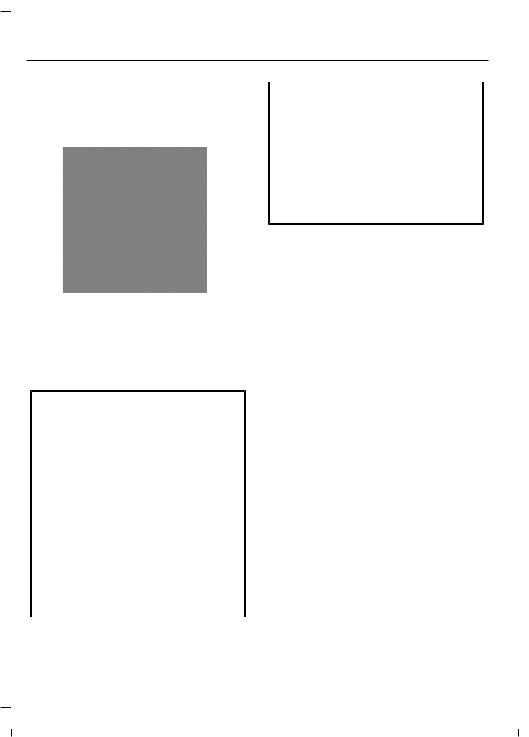
Child Safety
INSTALLING CHILD
RESTRAINTS
Child Restraints
E142594
Use a child restraint (sometimes called an infant carrier, convertible seat, or toddler seat) for infants, toddlers, or children weighing 40 lb (18 kg) or less (generally age four or younger).
Using Lap and Shoulder Belts


22

When installing a child restraint with combination lap and shoulder belts:
•Use the correct seatbelt buckle for that seating position.
•Insert the belt tongue into the proper buckle until you hear a snap and feel it latch. Make sure the tongue is securely fastened in the buckle.
•Keep the buckle release button pointing up and away from the child restraint , with the tongue between the child restraint and the release button, to prevent accidental unbuckling.
•Place the vehicle seat upon which the child restraint will be installed in the upright position.
•Put the seatbelt in the automatic locking mode. See Step 5. This vehicle does not require the use of a locking clip.
Perform the following steps when installing the child restraint with combination lap and shoulder belts:
Note: Although the child restraint illustrated is a forward facing child restraint, the steps are the same for installing a rear facing child restraint.
Escape (TM2) Canada/United States of America, enUSA, Edition date: 201807, Second-Printing
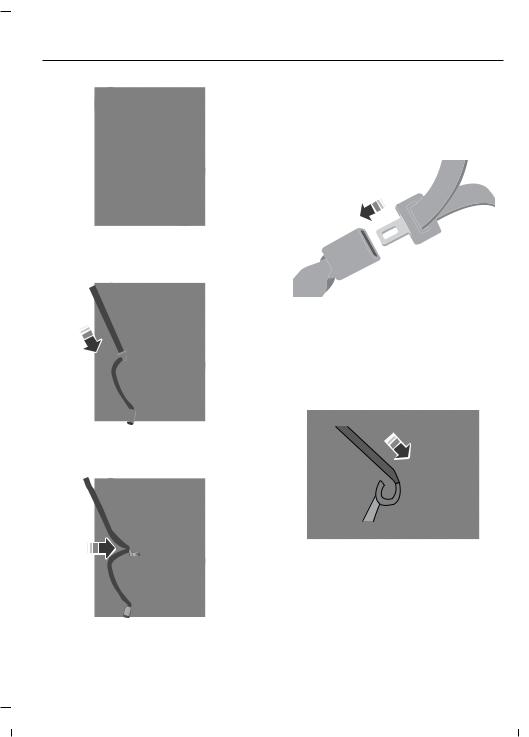
Child Safety
E142528
1.Position the child restraint in a seat with a combination lap and shoulder belt.
3.While holding the shoulder and lap belt portions together, route the tongue through the child restraint according to the child restraint manufacturer’s instructions. Be sure the belt webbing is not twisted.
E142529
2.Pull down on the shoulder belt and then grasp the shoulder belt and lap belt together.
E142530
E142531
4.Insert the belt tongue into the proper buckle (the buckle closest to the direction the tongue is coming from) for that seating position until you hear a snap and feel the latch engage. Make sure the tongue is latched securely by pulling on it.
E142875
5.To put the retractor in the automatic locking mode, grasp the shoulder portion of the belt and pull downward until you pull all of the belt out.
Note: The automatic locking mode is available on the front passenger and rear seats.
23
Escape (TM2) Canada/United States of America, enUSA, Edition date: 201807, Second-Printing
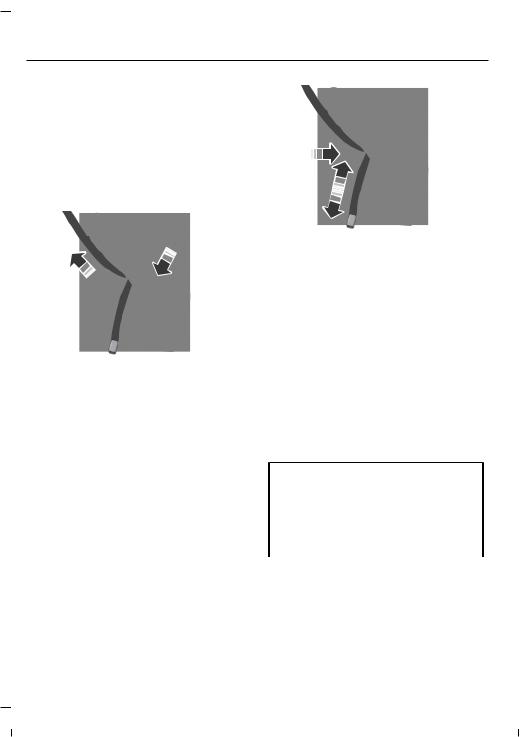
Child Safety
6.Allow the belt to retract to remove slack. The belt clicks as it retracts to indicate it is in the automatic locking mode.
7.Try to pull the belt out of the retractor to make sure the retractor is in the automatic locking mode (you should not be able to pull more belt out). If the retractor is not locked, unbuckle the belt and repeat Steps 5 and 6.
E142534
E142533
8.Remove remaining slack from the belt. Force the seat down with extra weight, for example, by pressing down or kneeling on the child restraint while pulling up on the shoulder belt in order to force slack from the belt. This is necessary to remove the remaining slack that exists once you add the extra weight of the child to the child restraint. It also helps to achieve the proper snugness of the child restraint to your vehicle. Sometimes, a slight lean toward the buckle will additionally help to remove remaining slack from the belt.
9.Attach the tether strap (if the child restraint is equipped).
24
10.Before placing the child in the seat, forcibly move the seat forward and back to make sure the seat is securely held in place. To check this, grab the seat at the belt path and attempt to move it side to side and forward and back. There should be no more than 1 in (2.5 cm) of movement for proper installation.
We recommend checking with a NHTSA Certified Child Passenger Safety Technician to make certain the child restraint is properly installed. In Canada, check with Transport Canada for referral to a Child Car Seat Clinic.
Using Lower Anchors and Tethers for CHildren (LATCH)

Escape (TM2) Canada/United States of America, enUSA, Edition date: 201807, Second-Printing

Child Safety

The LATCH system is composed of three vehicle anchor points: two lower anchors where the seat backrest and seat cushion meet (called the seat bight) and one top tether anchor behind that seating position.
LATCH compatible child restraints have two rigid or webbing mounted attachments that connect to the two lower anchors at the LATCH equipped seating positions in your vehicle. This type of attachment method eliminates the need to use seatbelts to attach the child restraint. However, you can still use the seatbelt to attach the child restraint. For forward-facing child restraints, you must attach the top tether strap to the proper top tether anchor, if a top tether strap has been provided with your child restraint.
E142535
25
Your vehicle has LATCH lower anchors for child restraint installation at the seating positions marked with the child restraint symbol.
E144054
The LATCH anchors are at the rear section of the rear seat between the cushion and seat backrest below the symbols as shown. Follow the child restraint manufacturer’s instructions to properly install a child restraint with LATCH attachments. Follow the instructions on attaching child restraints with tether straps.
Attach LATCH lower attachments of the child restraint only to the anchors shown.
UseofInboardLowerAnchorsfromthe
Outboard Seating Positions (Center
Seating Use)

Escape (TM2) Canada/United States of America, enUSA, Edition date: 201807, Second-Printing

Child Safety
The lower anchors at the center of the second row rear seat are spaced 18 in (46 cm) apart. A child restraint with rigid LATCH attachments cannot be installed at the center seating position. LATCH compatible child restraints (with attachments on belt webbing) can only be used at this seating position provided that the child restraint manufacturer’s instructions permit use with the anchor spacing stated. Do not attach a child restraint to any lower anchor if an adjacent child restraint is attached to that anchor.
Each time you use the child restraint, check that the seat is properly attached to the lower anchors and tether anchor, if applicable. Tug the child restraint from side to side and forward and back where it is secured to your vehicle. The seat should move less than 1 in (2.5 cm) when you do this for a proper installation.
If the child restraint is not anchored properly, the risk of a child being injured in a crash greatly increases.
Contact the manufacturer of your child restraint for information about ordering a tether strap, or to obtain a longer tether strap if the tether strap on your child restraint does not reach the appropriate top tether anchor in your vehicle.
Once you install the child restraint using either the seatbelt, the lower anchors of the LATCH system, or both, you can attach the top tether strap.
The tether strap anchors in your vehicle are in the following positions (shown from top view):
Combining Seatbelt and LATCH Lower
AnchorsforAttachingChildRestraints
When used in combination, either the seatbelt or the LATCH lower anchors may be attached first, provided a proper installation is achieved. Attach the tether strap afterward, if included with the child restraint.
Using Tether Straps
Many forward-facing child restraints include a tether strap which extends from the back of
the child restraint and hooks to an anchoring point called the top tether anchor. Tether straps are available as an accessory for many older child restraints.
26
E142537
Perform the following steps to install a child restraint with tether anchors:
Note: If you install a child restraint with rigid LATCH attachments, do not tighten the tether strap enough to lift the child restraint off your vehicle seat cushion when the child is seated in it. Keep the tether strap just snug without lifting the front of the child restraint. Keeping the child restraint just touching your vehicle seat gives the best protection in a severe crash.
Escape (TM2) Canada/United States of America, enUSA, Edition date: 201807, Second-Printing

Child Safety
1.Route the child restraint tether strap over the back of the seat. For the outermost seating positions, route the tether strap under the head restraint and between the head restraint posts. For the center seating positions, route the tether strap over the top of the head restraint. If needed, you can also remove the head restraints.
E142538
2.Locate the correct anchor on the back panel of the rear seat for the selected seating position. The anchors are labeled with the tether strap symbol and are partially covered by the gap panel. Pull the panel back to fully expose the anchors.
4.Tighten the child restraint tether strap according to the manufacturer’s instructions. If your child restraint system has a tether strap, and the child restraint manufacturer recommends its use, we also recommend its use.
BOOSTER SEATS

Use a belt-positioning booster seat for children who have outgrown or no longer properly fit in a child safety restraint (generally children who are less than 57 in (1.45 m) tall, are greater than age 4 and less than age 12, and between 40 lb (18 kg) and 80 lb (36 kg) and upward to 100 lb (45 kg) if recommended by your child restraint manufacturer). Many state and provincial laws require that children use approved booster seats until they reach age eight, a height of 57 in (1.45 m) tall, or 80 lb (36 kg).
Booster seats should be used until you can answer YES to ALL of these questions when seated without a booster seat:
E142539
3.Clip the tether strap to the anchor as shown.
27
Escape (TM2) Canada/United States of America, enUSA, Edition date: 201807, Second-Printing

Child Safety
If your backless booster seat has a removable shield, remove the shield. If a vehicle seating position has a low seat backrest or no head restraint, a backless booster seat may place your child’s head (as measured at the tops of the ears)
above the top of the seat. In this case,
move the backless booster to another seating position with a higher seat backrest or head restraint and lap and shoulder belts, or consider using a high back booster seat.
E142595
•Can the child sit all the way back against their vehicle seat backrest with knees bent comfortably at the edge of the seat cushion?
•Can the child sit without slouching?
•Does the lap belt rest low across the hips?
•Is the shoulder belt centered on the shoulder and chest?
•Can the child stay seated like this for the whole trip?
Always use booster seats in conjunction with your vehicle lap and shoulder belt.
Types of Booster Seats
E68924
•Backless booster seats
28
E70710
•High back booster seats
If, with a backless booster seat, you cannot find a seating position that adequately supports your child’s head, a high back booster seat would be a better choice.
Children and booster seats vary in size and shape. Choose a booster that keeps the lap belt low and snug across the hips, never up across the stomach, and lets you adjust the shoulder belt to cross the chest and rest snugly near the center of the shoulder. The following drawings compare the ideal fit (center) to a shoulder belt uncomfortably close to the neck and a shoulder belt that could slip off the shoulder. The drawings also show how the lap belt should be low and snug across the child’s hips.
Escape (TM2) Canada/United States of America, enUSA, Edition date: 201807, Second-Printing

Child Safety
E142596
E142597
If the booster seat slides on the vehicle seat upon which it is being used, placing a rubberized mesh sold as shelf or carpet liner under the booster seat may improve this condition. Do not introduce any item thicker than this under the booster seat. Check with the booster seat manufacturer’s instructions.
CHILD RESTRAINT
POSITIONING



29
Escape (TM2) Canada/United States of America, enUSA, Edition date: 201807, Second-Printing

Child Safety
the child restraint manufacturer’s instructions and warnings provided for installation and use in conjunction with the instructions and warnings provided by your vehicle manufacturer. A safety seat that is improperly installed or utilized, is inappropriate for your child’s height, age, or weight or does not properly fit the child may increase the risk of serious injury or death.





30
Escape (TM2) Canada/United States of America, enUSA, Edition date: 201807, Second-Printing

Child Safety
Recommendations for Attaching Child Safety Restraints for Children
|
Use Any Attachment Method as Indicated Below by X |
||||||
|
Combined |
LATCH |
LATCH |
Seatbelt |
Seatbelt |
Seatbelt |
|
|
Restraint |
Weight of |
(Lower |
(Lower |
and Top |
and LATCH |
Only |
|
Child and |
Anchors |
Anchors |
Tether |
(Lower |
||
|
Type |
||||||
|
Child |
and Top |
Only) |
Anchor |
Anchors |
||
|
Restraint |
Tether |
and Top |
||||
|
Anchor) |
Tether |
|||||
|
Anchor) |
||||||
|
Rear facing |
Up to 65 lb |
X |
X |
|||
|
child |
(29.5 kg) |
|||||
|
restraint |
||||||
|
Rear facing |
Over 65 lb |
X |
||||
|
child |
(29.5 kg) |
|||||
|
restraint |
||||||
|
Forward |
Up to 65 lb |
|||||
|
facing |
X |
X |
X |
|||
|
child |
(29.5 kg) |
|||||
|
restraint |
||||||
|
Forward |
Over 65 lb |
|||||
|
facing |
X |
X |
||||
|
child |
(29.5 kg) |
restraint
Note: The child restraint must rest tightly against the vehicle seat upon which it is installed. It may be necessary to lift or remove the head restraint. See Seats (page 118).
CHILD SAFETY LOCKS
When these locks are set, the rear doors cannot be opened from the inside.
31
Escape (TM2) Canada/United States of America, enUSA, Edition date: 201807, Second-Printing

Child Safety
E112197
The childproof locks are located on the rear edge of each rear door and must be set separately for each door.
Left-Hand Side
Turn counterclockwise to lock and clockwise to unlock.
Right-Hand Side
Turn clockwise to lock and counterclockwise to unlock.
32
Escape (TM2) Canada/United States of America, enUSA, Edition date: 201807, Second-Printing

Seatbelts
PRINCIPLE OF OPERATION










All seating positions in this vehicle have lap and shoulder safety belts. All occupants of the vehicle should always properly wear their safety belts, even when an airbag supplemental restraint system is provided.
The safety belt system consists of:
•lap and shoulder safety belts
•shoulder safety belt with automatic locking mode, (except driver safety belt)
•height adjuster at the front outboard seating positions
33
Escape (TM2) Canada/United States of America, enUSA, Edition date: 201807, Second-Printing

Seatbelts
•retractor and anchor pretensioner at the front outboard seating positions
•belt tension sensor at the front outboard passenger seating position
•safety belt warning light and chime
•crash sensors and monitoring system with readiness indicator.
The safety belt pretensioners are designed to activate in frontal, near-frontal and side crashes, and in rollovers. The safety belt pretensioners on the retractor and anchor at the front seating positions are designed to tighten the safety belts firmly against the occupant’s body when activated. This helps increase the effectiveness of the safety belts. In frontal crashes, the safety belt pretensioners can be activated alone or, if the crash is of sufficient severity, together with the front airbags.
FASTENING THE SEATBELTS
The front outboard and rear safety restraints in the vehicle are combination lap and shoulder belts.
E142587
1.Insert the belt tongue into the proper buckle (the buckle closest to the direction the tongue is coming from) until you hear a snap and feel it latch. Make sure the tongue is securely fastened in the buckle.
E142588
2.To unfasten, press the release button and remove the tongue from the buckle.
E142589
When in use, place the rear seatbelts in the belt guides on the outermost seat backrests.
34
Escape (TM2) Canada/United States of America, enUSA, Edition date: 201807, Second-Printing

Seatbelts
UsingSeatbeltsDuringPregnancy

E142590
Pregnant women should always wear their seatbelt. Position the lap belt portion of a combination lap and shoulder belt low across the hips below the belly and worn as tight as comfort allows. Position the shoulder belt to cross the middle of the shoulder and the center of the chest.
Seatbelt Locking Modes

35
All safety restraints in the vehicle are combination lap and shoulder belts. The driver seatbelt has the first type of locking mode, and the front outboard passenger and rear seat seatbelts have both types of locking modes described as follows:
Vehicle Sensitive Mode
This is the normal retractor mode, which allows free shoulder belt length adjustment to your movements and locking in response to vehicle movement. For example, if the driver brakes suddenly or turns a corner sharply, or the vehicle receives an impact of about 5 mph
(8 km/h) or more, the combination seatbelts lock to help reduce forward movement of the driver and passengers.
In addition, the retractor is designed to lock if you pull the webbing out too quickly. If the seatbelt retractor locks, slowly lower the height adjuster to allow the seatbelt to retract. If the retractor does not unlock, pull the seatbelt out slowly then feed a small length of webbing back toward the stowed position. For rear seatbelts, recline the rear seat backrest or push the seat backrest cushion away from the seatbelt. Feed a small length of webbing back toward the stowed position.
Automatic Locking Mode
In this mode, the shoulder belt automatically pre-locks. The belt still retracts to remove any slack in the shoulder belt. The automatic locking mode is not available on the driver seatbelt.
When to Use the Automatic Locking Mode
Use this mode any time a child safety seat, except a booster, is installed in passenger front or rear seating positions. Properly restrain children 12 years old and under in a rear seating position whenever possible. See Child Safety (page 20).
Escape (TM2) Canada/United States of America, enUSA, Edition date: 201807, Second-Printing

Seatbelts
How to Use the Automatic Locking Mode
E142591
1.Buckle the combination lap and shoulder belt.
2.Grasp the shoulder portion and pull downward until you pull the entire belt out. Allow the belt to retract. As the belt retracts, you will hear a clicking sound. This indicates the seatbelt is now in the automatic locking mode.
How to Disengage the Automatic Locking Mode
Unbuckle the combination lap and shoulder belt and allow it to retract completely to disengage the automatic locking mode and turn on the vehicle sensitive (emergency) locking mode.
How to Extract Seatbelts in the Rear Outermost Positions
3.Return the seat backrest to its desired upright position.
For vehicles with rear seats that do not recline or are locked with the seat in its full rear recline position:
1.Grasp the seatbelt webbing at the top of the seat backrest.
2.Pull the seatbelt webbing forward, firmly.
3.After pulling the seatbelt forward, allow the seatbelt to feed back into the seatbelt retractor as much as possible. If necessary, press the seat backrest down to allow the seatbelt webbing to retract further.
4.The seatbelt should then unlock.
5.If the seatbelt does not unlock, repeat steps 1-3.
SEATBELT HEIGHT
ADJUSTMENT

Seatbelts in the rear outermost positions can lock if you firmly return the seat backrest to its upright position. You can unlock the seatbelts using the following procedures.
For vehicles where the rear seats recline:
1.Recline the seat to its full rear recline position.
2.The seatbelt should then unlock.
36
Escape (TM2) Canada/United States of America, enUSA, Edition date: 201807, Second-Printing

Seatbelts
To adjust the shoulder belt height, squeeze the button and slide the height adjuster up or down. Release the button and pull down on the height adjuster to make sure it is locked in place.
|
SEATBELT WARNING LAMP |
|
|
AND INDICATOR CHIME |
|
|
This lamp illuminates and an |
|
|
indicator chime will sound if the |
|
|
driver seatbelt has not been |
|
|
fastened when the vehicle’s ignition is |
|
|
turned on. |
|
|
E87511 |
|
|
Conditions of operation |
|
|
If |
Then |
|
The driver seatbelt is not buckled before |
The seatbelt warning lamp illuminates and |
|
the ignition switch is turned to the on posi- |
the indicator chime sounds for a few |
|
tion… |
seconds. |
|
The driver seatbelt is buckled while the |
The seatbelt warning lamp and indicator |
|
warning lamp is illuminated and the indic- |
chime turn off. |
|
ator chime is sounding… |
The driver seatbelt is buckled before the
ignition switch is turned to the on position…
SEATBELT REMINDER
Belt-Minder™
This feature supplements the safety belt warning function by providing additional reminders that intermittently sound a tone and illuminate the safety belt warning light when you are in the driver seat or you have a front seat passenger and a safety belt is unbuckled.
The seatbelt warning lamp and indicator chime remain off.
The system uses information from the front passenger sensing system to determine if a front seat passenger is present and therefore potentially in need of a warning. To avoid activating the Belt-Minder feature for objects you place in the front passenger seat, only the front seat passengers receive warnings as determined by the front passenger sensing system.
37
Escape (TM2) Canada/United States of America, enUSA, Edition date: 201807, Second-Printing

Seatbelts
If the Belt-Minder warnings expire (warnings for about five minutes) for one passenger (driver or front passenger), the
other passenger can still cause the Belt-Minder feature to turn on.
|
If… |
Then… |
|
You and the front seat passenger buckle |
The Belt-Minder feature will not activate. |
|
your safety belts before you switch the |
|
|
ignition on or less than 1-2 minutes elapse |
|
|
after you switch the ignition on… |
You or the front seat passenger do not buckle your safety belts before your vehicle reaches at least 6 mph (9.7 km/h) and 1-2 minutes elapse after you switch the ignition on…
The safety belt for the driver or front passenger is unbuckled for about 1 minute while the vehicle is traveling at least 6 mph (9.7 km/h) and more than 1-2 minutes elapse after you switch the ignition on…
Deactivating and Activating the
Belt-Minder Feature

Note: The driver and front passenger warnings switch on and off independently. When you perform this procedure for one seating position, do not buckle the other position as this will terminate the process.
Read Steps 1 — 4 thoroughly before proceeding with the programming procedure.
The Belt-Minder feature activates, the safety belt warning light illuminates and a warning tone sounds for 6 seconds every 25 seconds, repeating for about 5 minutes or until you and the front seat passenger buckle your safety belts.
The Belt-Minder feature activates, the safety belt warning light illuminates and a warning tone sounds for 6 seconds every 25 seconds, repeating for about 5 minutes or until you and the front seat passenger buckle your safety belts.
Before following the procedure, make sure that:
•The parking brake is set.
•The transmission is in park (P).
•The ignition is off.
•The driver and front passenger safety belts are unbuckled.
1.Switch the ignition on. Do not start the engine.
2.Wait until the safety belt warning light turns off (about one minute). After Step 2, wait an additional five seconds before proceeding with Step 3. Once you start Step 3, you must complete the procedure within 60 seconds.
3.For the seating position you are switching off, buckle then unbuckle the safety belt three times at a moderate speed, ending in the unbuckled state. After Step 3, the safety belt warning light turns on.
38
Escape (TM2) Canada/United States of America, enUSA, Edition date: 201807, Second-Printing

Seatbelts
4.While the safety belt warning light is on, buckle and then unbuckle the safety belt. After Step 4, the safety belt warning light flashes for confirmation.
•This will switch the feature off for that seating position if it is currently on.
•This will switch the feature on for that seating position if it is currently off.
CHILD RESTRAINT AND SEATBELT MAINTENANCE
Inspect the vehicle seatbelts and child safety seat systems periodically to make sure they work properly and are not damaged. Inspect the vehicle and child restraint seatbelts to make sure there are no nicks, tears or cuts. Replace if necessary. All vehicle seatbelt assemblies, including retractors, buckles, front seatbelt buckle assemblies, buckle support assemblies (slide bar-if equipped), shoulder belt height adjusters (if equipped), shoulder belt guide on seat backrest (if equipped), child safety seat LATCH and tether anchors, and attaching hardware, should be inspected after a crash. Read the child restraint manufacturer’s instructions for additional inspection and maintenance information specific to the child restraint.
We recommend that all seatbelt assemblies in use in vehicles involved in a crash be replaced. However, if the crash was minor and an authorized dealer finds that the belts do not show damage and continue to operate properly, they do not need to be replaced. Seatbelt assemblies not in use during a crash should also be inspected and replaced if either damage or improper operation is noted.
Properly care for seatbelts. See Vehicle Care (page 267).
SEATBELT EXTENSION





If, because of body size or driving position, it is not possible to properly fasten the seatbelt over your lap and shoulder, an extension that is compatible with the seatbelts is available free of charge from our dealers. Only use our seatbelt extensions made by the original equipment seatbelt manufacturer with our seatbelts. Ask your authorized dealer if your extension is compatible with your vehicle restraint system.
39
Escape (TM2) Canada/United States of America, enUSA, Edition date: 201807, Second-Printing

Personal Safety System™
The Personal Safety System provides an improved overall level of frontal crash protection to front seat occupants and is designed to help further reduce the risk of airbag-related injuries. The system is able to analyze different occupant conditions and crash severity before activating the appropriate safety devices to help better protect a range of occupants in a variety of frontal crash situations.
The Vehicle Personal Safety System consists of:
•Driver and passenger dual-stage airbag supplemental restraints.
•Front seat outermost seatbelts with pretensioners, energy management retractors and seatbelt usage sensors.
•Driver seat position sensor.
•Passenger seat position sensor.
•Front passenger sensing system.
•Passenger airbag off and on indicators.
•Front crash severity sensors.
•Restraints control module with impact and safing sensors.
•Restraint system warning lamp and tone.
•The electrical wiring for the airbags, crash sensors, seatbelt pretensioners, front seatbelt usage sensors, driver seat position sensor, front passenger sensing system and indicators.
40
How Does the Personal Safety
System Work?
The Personal Safety System can adapt the deployment strategy of the safety devices according to crash severity and occupant conditions. A collection of crash and occupant sensors provides information to the restraints control module. During a crash, the restraints control module may deploy the seatbelt pretensioners, one or both stages of the dual-stage airbags based on crash severity and occupant conditions.
Escape (TM2) Canada/United States of America, enUSA, Edition date: 201807, Second-Printing

Supplementary Restraints System
PRINCIPLE OF OPERATION









The airbags are a supplemental restraint system and are designed to work with the seatbelts to help protect the driver and right front passenger from certain upper body injuries. Airbags do not inflate slowly; there is a risk of injury from a deploying airbag.
Note: You will hear a loud bang and see a cloud of harmless powdery residue if an airbag deploys. This is normal.
The airbags inflate and deflate rapidly upon activation. After airbag deployment, it is normal to notice a smoke-like, powdery residue or smell the burnt propellant. This may consist of cornstarch, talcum powder (to lubricate the bag) or sodium compounds (for example, baking soda) that result from the combustion process that inflates the airbag. Small amounts of sodium hydroxide may be present which may irritate the skin and eyes, but none of the residue is toxic.
41
Escape (TM2) Canada/United States of America, enUSA, Edition date: 201807, Second-Printing

Supplementary Restraints System
While the system is designed to help reduce serious injuries, contact with a deploying airbag may also cause abrasions or swelling. Temporary hearing loss is also a possibility as a result of the noise associated with a deploying airbag. Because airbags must inflate rapidly and with considerable force, there is the risk of death or serious injuries such as fractures, facial and eye injuries or internal injuries, particularly to occupants who are not properly restrained or are otherwise out of position at the time of airbag deployment. Thus, it is extremely important that occupants be properly restrained as far away from the airbag module as possible while maintaining vehicle control.
Routine maintenance of the airbags is not required.
E151127
The driver and front passenger airbags will deploy during significant frontal and near frontal crashes.
The driver and passenger front airbag system consists of:
•Driver and passenger airbag modules.
DRIVER AND PASSENGER AIRBAGS



•Front passenger sensing system.
· Crash sensors and monitoring
system with readiness indicator. See CrashSensorsandAirbag
Indicator (page 48).
ProperDriverandFrontPassenger
Seating Adjustment

To properly position yourself away from the airbag:
•Move your seat to the rear as far as you can while still reaching the pedals comfortably.
•Recline the seat slightly (one or two degrees) from the upright position.
42
Escape (TM2) Canada/United States of America, enUSA, Edition date: 201807, Second-Printing

Supplementary Restraints System
After all occupants have adjusted their seats and put on seatbelts, it is very important that they continue to sit properly. A properly seated occupant sits upright, leaning against the seatback, and centered on the seat cushion, with their feet comfortably extended on the floor. Sitting improperly can increase the chance of injury in a crash event. For example, if an occupant slouches, lies down, turns sideways, sits forward, leans forward or sideways, or puts one or both feet up, the chance of injury during a crash is greatly increased.
Children and Airbags

E142846
FRONTPASSENGERSENSING SYSTEM




This system works with sensors that are part of the front passenger seat and seatbelt to detect the presence of a properly-seated occupant and determine if the front passenger frontal airbag should be enabled (may inflate) or not.
Children must always be properly restrained. Accident statistics suggest that children are safer when properly restrained in the rear seating positions than in the front seating position. Failure to follow these instructions may increase the risk of injury in a crash.
43
E225141
The indicators are on the center stack of the instrument panel.
Escape (TM2) Canada/United States of America, enUSA, Edition date: 201807, Second-Printing

Supplementary Restraints System
The front passenger sensing system uses passenger airbag status indicators that illuminate indicating that the front passenger frontal airbag is either on (enabled) or off (disabled).
Note: The indicators illuminate briefly when you first switch the ignition on to confirm they are functional.
The front passenger sensing system is designed to disable (will not inflate) the front passenger frontal airbag when the front passenger seat is unoccupied, or a rear facing infant seat, a forward-facing child restraint, or a booster seat is detected. Even with this technology, parents are strongly encouraged to always properly restrain children in the rear seat. The sensor also switches off the passenger front airbag and seat-mounted side airbag when the passenger seat is empty.
•When the front passenger sensing system disables (will not inflate) the front passenger frontal airbag, the passenger airbag status off indicator illuminates and stays lit to remind you that the front passenger frontal airbag is disabled.
•If you have installed the child restraint and the passenger airbag status on indicator illuminates, then switch the vehicle off, remove the child restraint from the vehicle and reinstall the restraint following the child restraint manufacturer’s instructions.
The front passenger sensing system is designed to enable (may inflate) the front passenger frontal airbag anytime the system senses that a person of adult size is sitting properly in the front passenger seat.
•When the front passenger sensing system enables the front passenger frontal airbag (may inflate), the passenger airbag status on indicator illuminates and remains illuminated.
If a person of adult size is sitting in the front passenger seat, but the passenger airbag is disabled, it is possible that the person is not sitting properly in the seat. If this happens:
•Switch the vehicle off and ask the person to place the seat backrest in the full upright position.
•Have the person sit upright in the seat, centered on the seat cushion, with the person’s legs comfortably extended.
•Restart the vehicle and have the person remain in this position for about two minutes. This allows the system to detect that person and enables the passenger frontal airbag.
•If the passenger airbag status off indicator remains lit even after this, advise the person to ride in the rear seat.
|
Occupant |
Passenger Airbag Status |
Passenger Airbag |
|
|
Indicator |
|||
|
Empty |
OFF: Lit |
Disabled |
|
|
ON: Unlit |
|||
|
Child |
OFF: Lit |
Disabled |
44
Escape (TM2) Canada/United States of America, enUSA, Edition date: 201807, Second-Printing

Supplementary Restraints System
|
Occupant |
Passenger Airbag Status |
Passenger Airbag |
|
Indicator |
||
|
ON: Unlit |
||
|
Adult |
OFF: Unlit |
Enabled |
ON: Lit
Note: When the passenger airbag status off indicator illuminates, the passenger side airbag (seat mounted) may be disabled to avoid the risk of airbag deployment injuries.
After all occupants have adjusted their seats and put on seatbelts, it is very important that they continue to sit properly. A properly seated occupant sits upright, leaning against the seat backrest, and centered on the seat cushion, with their feet comfortably extended on the floor. Sitting improperly can increase the chance of injury in a crash event. For example, if an occupant slouches, lies down, turns sideways, sits forward, leans forward or sideways, or puts one or both feet up, the chance of injury during a crash greatly increases.
If you think that the status of the passenger airbag off indicator is incorrect, check for the following:
•Objects lodged underneath the seat.
•Objects between the seat cushion and the center console.
•Objects hanging off the seat backrest.
•Objects stowed in the seat backrest map pocket.
•Objects placed on the occupant’s lap.
•Cargo interference with the seat.
•Other passengers pushing or pulling on the seat.
•Rear passenger feet and knees resting or pushing on the seat.
The conditions listed above may cause the weight of a properly seated occupant to be incorrectly interpreted by the passenger sensing system. The person in the front passenger seat may appear heavier or lighter due to the conditions described in the list above.
Make sure the front passenger
sensing system is operating properly. See Crash Sensors
and Airbag Indicator (page 48).
Do not attempt to repair or service the system. Take your vehicle immediately to an authorized dealer.
If it is necessary to modify an advanced front airbag system to accommodate a person with disabilities, contact your authorized dealer.
SIDE AIRBAGS

45
Escape (TM2) Canada/United States of America, enUSA, Edition date: 201807, Second-Printing

Supplementary Restraints System




The side airbags are located on the outboard side of the seatbacks of the front seats. In certain sideways crashes, the airbag on the side affected by the crash will be inflated. The airbag was designed to inflate between the door panel and occupant to further enhance the protection provided occupants in side impact crashes.
E152533
The system consists of the following:
•A label or embossed side panel indicating that side airbags are fitted to your vehicle.
•Side airbags located inside the driver and front passenger seatbacks.
•Front passenger sensing system.
•Crash sensors and monitoring system with readiness indicator. See Crash Sensors and Airbag Indicator (page 48).
Note: The passenger sensing system will deactivate the passenger seat-mounted side airbag if it detects an empty passenger seat.
The design and development of the side airbag system included recommended testing procedures that were developed by a group of automotive safety experts known as the Side Airbag Technical Working Group. These recommended testing procedures help reduce the risk of injuries related to the deployment of side airbags.
46
Escape (TM2) Canada/United States of America, enUSA, Edition date: 201807, Second-Printing

Supplementary Restraints System
DRIVER KNEE AIRBAG
A driver’s knee airbag is located under the instrument panel. During a crash, the restraints control module may activate the driver’s knee airbag based on crash severity and occupant conditions. Under certain crash and occupant conditions, the driver’s knee airbag may deploy but the driver’s front airbag may not activate. As with front and side airbags, it is important to be properly seated and restrained to reduce the risk of death or serious injury.
Make sure the knee airbag is
operating properly. See Crash
Sensors and Airbag Indicator
(page 48).
SAFETY CANOPY™






The Safety Canopy deploys during significant side crashes or when a certain likelihood of a rollover event is detected by the rollover sensor. The Safety Canopy is mounted to the roof side rail sheet metal, behind the headliner, above each row of seats. In certain sideways crashes or rollover events, the Safety Canopy will be activated, regardless of which seats are occupied. The Safety Canopy is designed to inflate between the side window area and occupants to further enhance protection provided in side impact crashes and rollover events.
47
Escape (TM2) Canada/United States of America, enUSA, Edition date: 201807, Second-Printing







